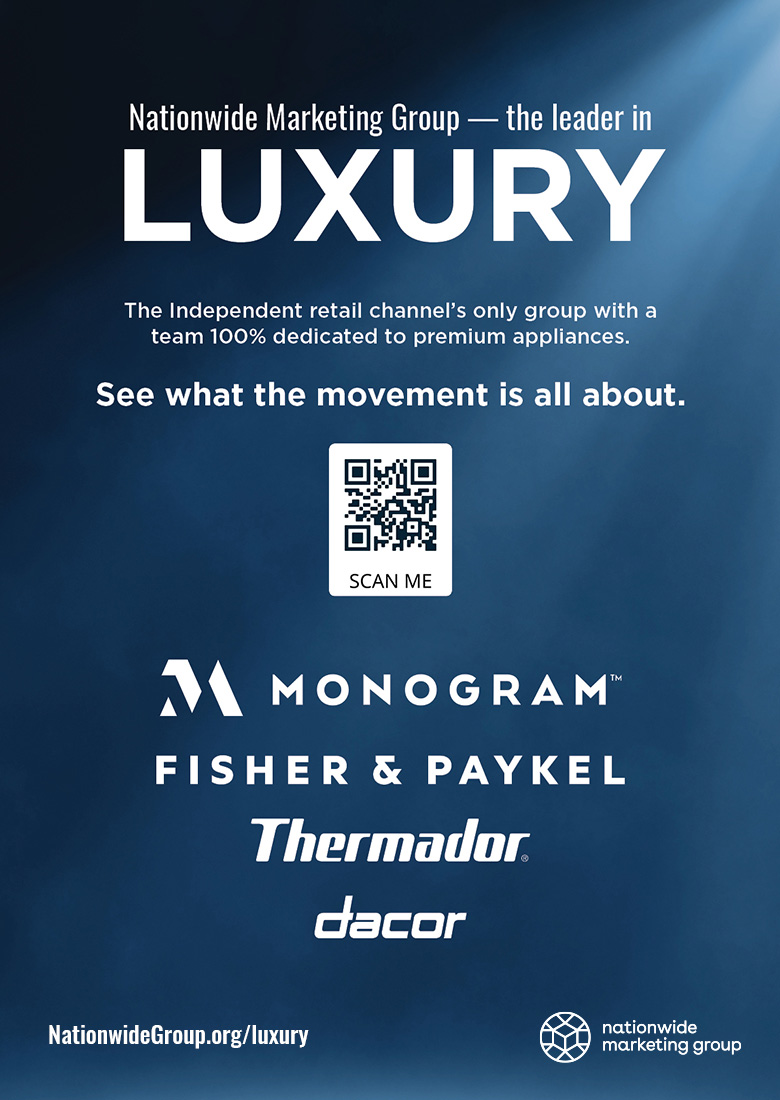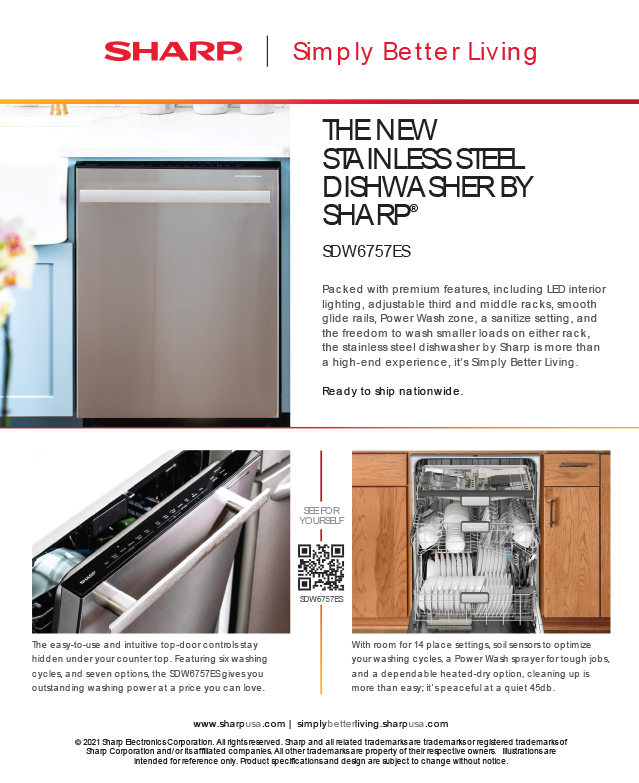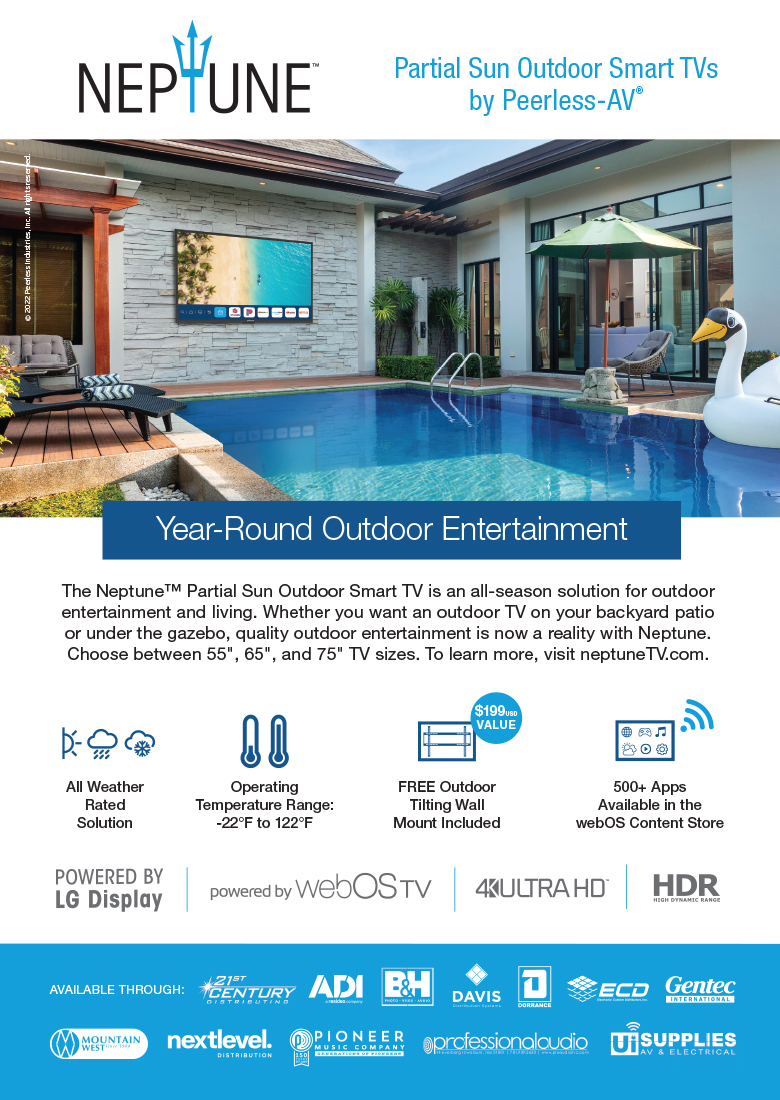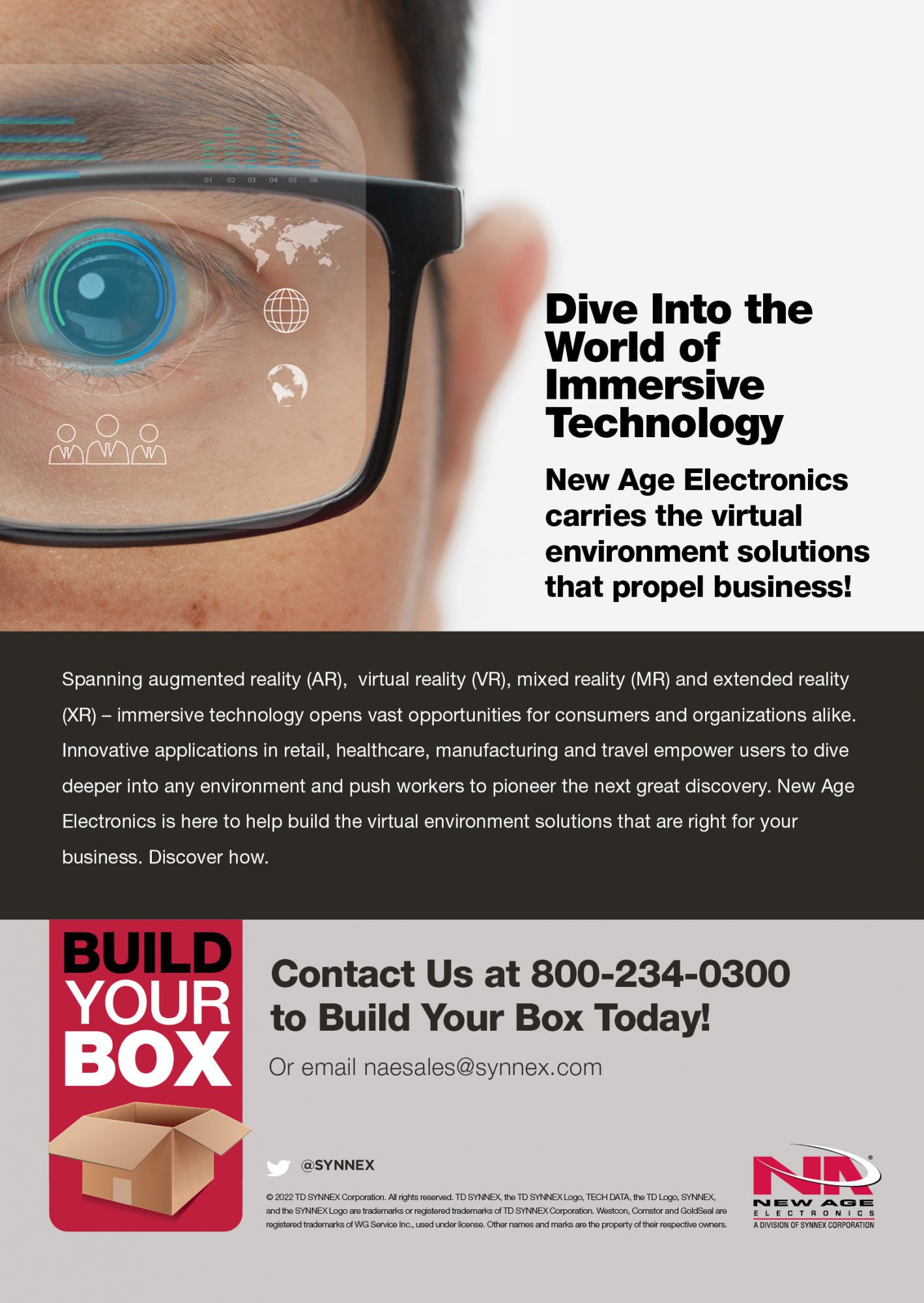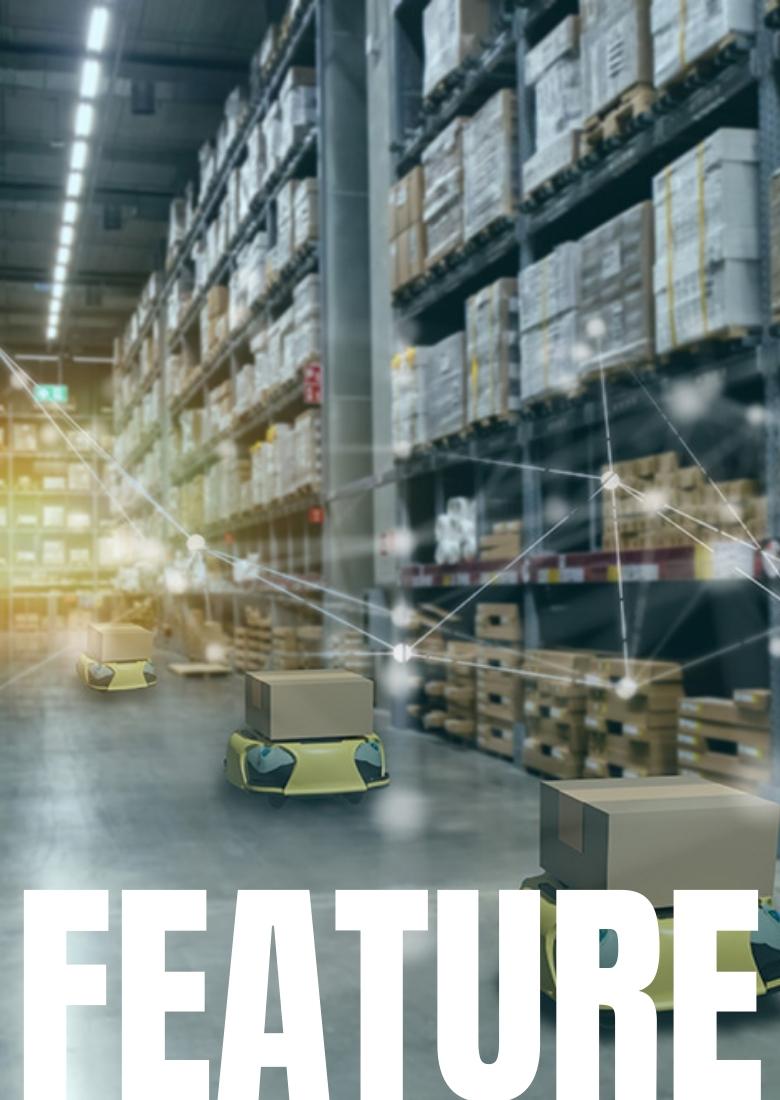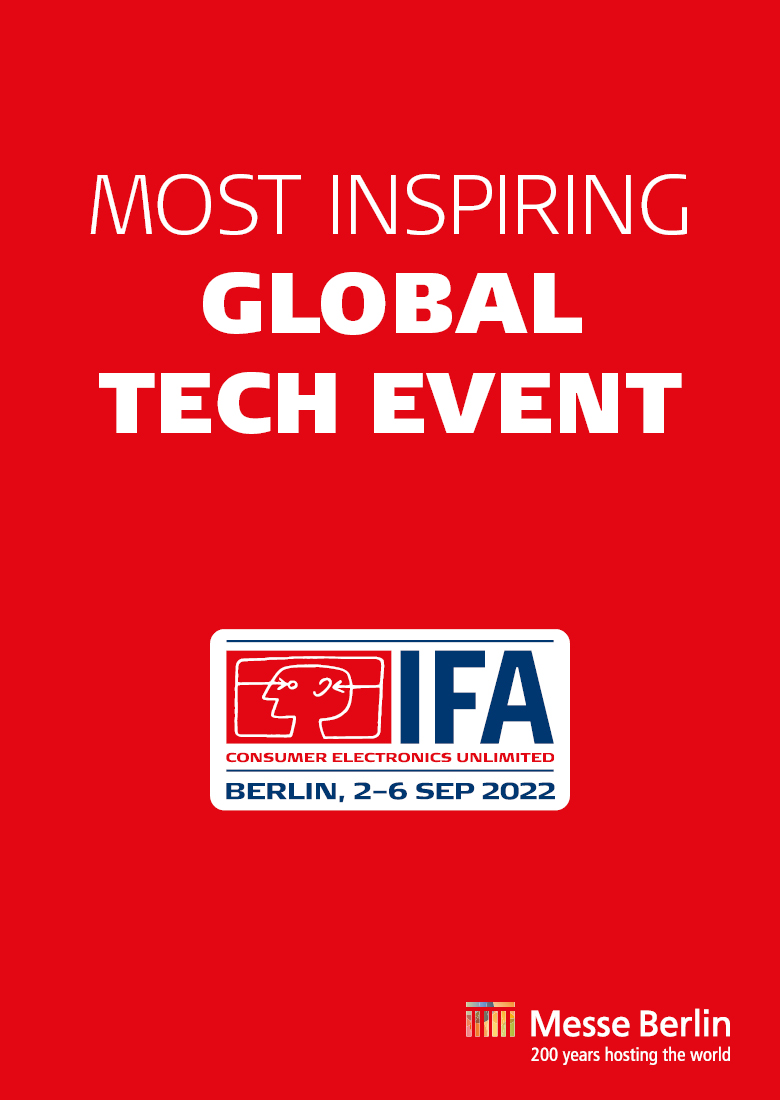This issue’s cover story focuses on robotics, everything from the latest trends to the coolest new consumer models that do housework, lawnmowing, pet entertaining, kid monitoring, and more. Plus, the latest in baby tech. appliances, and spring accessories (such as allergy-reducing air purifiers), as well as a focus on experiential retail.

Robots are Everywhere
These Days
Life has changed slowly as we know it; we now have robotics in every aspect of everyday life. We all know about robotic vacuum cleaners, but today, robots are used to cut the lawn or clean the bottom of the pool, wash our windows, or even iron our clothes — although my dry cleaner, Tommy, would be terribly upset if I used the latter. (Tommy is the best… just sayin’…) The new Amazon robot, ASTRO, is already on my Christmas list. Since I work at home, it would be cool for my Frenchie, Lilly, and I to have company.
Yes, robots are everywhere these days. Therefore, in our May issue, we cover this ever-growing slice of the market. We feature the best new consumer robots, including the NINA Camera Robot by Doosan Robotics. This uncanny robot more than mimics the movement of the human arm, so it can take pictures at any and every angle.
We also provide a look at LG Electronics Business Solutions’ take on how robotics help to streamline workflows, and how future innovations will continue driving economic growth. Robotics make us work smarter — and in this issue, we cover how kitchens and bathrooms are smarter than ever.
Every month, we look at retailing, and this month, we cover e-commerce success tips for your business, and give you a glimpse of experiential retail at NIO in Beijing. NIO is successful example of a local brand integrating experiential retail into its commercial strategy. You want to make sure to check out this article to see what an elevated shopping experience can be like — so supreme, that you may never leave the store.
In addition, this issue examines the latest in baby tech, provides a cool preview of Alpine car electronics, and offers a wonderful Spring Accessories column by Fred Towns of New Age Electronics. Fred is someone I value and look up to, and I am always interested in his views of our world and our business.
As we enter more deeply into Spring and the realm of robotics, remember that, in today’s world, nothing can replace the human spirit. So, make sure to hug someone close to you, and tell them what they mean to you. Robots may always be around going forward — but we will not. So live, laugh, and love.
As always, any comments and/or questions – please contact me at
tmonteleone@ctlab.media – our great team would love to hear from you!
As always, any comments and/or questions – please contact me at tmonteleone@ctlab.media – our great team would love to hear from you!
Tony Monteleone,
Group Publisher of CT Lab Global Media

A WORD FROM OUR EDITOR IN CHIEF
Why Are
Consumer Robots
Still So Dumb?

Our fascination with humanoid robots is older than many of us realize. As far back as the 17th century, French inventor Jacques de Vaucanson used the same technologies as clocks to develop the “The Duck,” a mechanical automaton that could simulate motions for eating, drinking, and even defacating. The automata craze continued through the 18th- and 19th-centuries in France and Switzerland, among other locations, and made its way into fantastical novels by French writers Jules Verne and August Villiers de L’Isle-Adam, who wrote L’Eve Future (“The Future Eve”), which is among the first works to use the term “Android.” These innovations led to bigger and more practical inventions such as the automatic loom, which in some ways parallels the relationship between whimsical and practical consumer robots and high-performance enterprise robots.
Robots for fun and robots for business have been around forever, so why don’t we have Rosie from The Jetsons yet? The all-in-one humanoid robot that can cook, clean, shop, and keep the family company – as well as walk and climb stairs like a human – remains elusive. Yes, we’ve made improvements in the “AI” part of the equation, with cloud connectivity allowing for real-time and authoritative responses via Alexa and Google Assistant, and there are certainly some innovations on the four-legged robo-dog front, but getting a bipedal robot to both climb stairs and have a real personality that can physically manifest its AI smarts? We aren’t there yet. That’s because the development of AI is more of a computer science endeavor, while getting a robot to move around like a human is more of an engineering feat (similar to what car and defense companies do). State-of-the-art bipedal robots like Honda’s now-discontinued Asimo may have moved around believably like a human, but it was as dumb as a brick.
Even so, today’s not-all-in-one consumer robots have come a long way since 2002, when iRobot released its first Roomba robotic vacuum cleaner. Its geofencing via beacons seems so rudimentary compared to today’s computer vision- and light sensor-based robovacs from Roborock and Ecovacs. Today’s state-of-the-art models can map rooms, mop and vacuum, clean themselves, and essentially figure out a lot on their own. And these puck-like, rolling housecleaners can tackle other domestic chores, too, from cleaning windows and pools to mowing lawns.
On the electric friend front, Amazon recently released the Astro and is working on the Ring Always Home Cam, which is essentially a flying Ring camera that can patrol your home in ways that will never end up tangled in cable clutter on the floor. But consumers don’t have to spend an arm and a leg to get some computerized companionship for their kids and pets. Even the $200 affordable new Enabot Ebo Air robot knows how to maneuver its way around a room, avoiding obstacles and tackling multiple surfaces with aplomb. (Not getting stuck in a nest of cables, though? Not so much.)
So there’s still a lot of innovation and improvement to be expected on the consumer robot front, but for basic chores and light fun, today’s models are worth the price of admission. For a snapshot of the marketplace, take a look at our roundup of consumer robots in this issue.

Tom Samiljan

CE RETAIL TECHNOLOGY
May 2022 CE News

BNPL Services Will Take Over More of the eCommerce Market
According to the 2022 Global Payments Report from FIS, BNPL transactions are projected to account for roughly $438 billion or 5.3 percent of global eCommerce transaction value by 2025. BNPL market projections for the U.S. are even higher. The up-and-coming service market, featuring Affirm, Afterpay, Klarna, PayPal Credit, Sezzle, and Zip, is projected to account for nine percent of eCommerce by 2025.
Holoride Will Bring VR Entertainment to Audi Cars
Audi has announced that it will begin supporting Holoride’s in-car virtual reality technology starting this summer, when Audi will begin shipping cars with the necessary software to sync with Holoride-compatible headsets. Models that will feature this upgraded infotainment system include the A4, A6, A8, Q5, and e-Tron GT. The in-drive entertainment content from Holoride allows passengers to play interactive games that adapt to the car’s movements.


Pinterest Adds Direct eCommerce Feature
At its annual advertiser event in March, Pinterest announced a new feature allowing customers to make purchases directly within its app. Transactions on the Pinterest app will be handled by Checkout, an online payment solutions provider that is tied to Shopify. According to data compiled by Pinterest, profiles with links to merchant details were 16 percent more likely to make a sale than those without.
Amazon, Apple, Dell, and Ikea Pull Out of Russia
Many large tech and retail companies, including Amazon, Apple, Dell, and Ikea, have halted operations in Russia. These decisions come in response to the invasion of Ukraine. On its decision to halt business, Ikea stated: “The war has both a huge human impact and is resulting in serious disruptions to supply chain and trading conditions, which is why the company groups have decided to temporarily pause IKEA operations in Russia.”


Target Zero Helps Consumers to Shop Sustainably
Target has launched its new Target Zero initiative, which aims to give consumers the tools and information they need to make sustainable purchasing decisions. Under the Target Zero initiative, consumers both online and in-store will easily be able to distinguish products that are refillable, made from recycled consent, and feature reusable or compostable packaging. Think of Target Zero as the company’s sustainable seal of approval.
APPLIANCES
What Appliance Trends
to Look For in 2022
Experts point to products that are faster, more healthful,
and increasingly sustainable.
BY ERINN LOUCKS
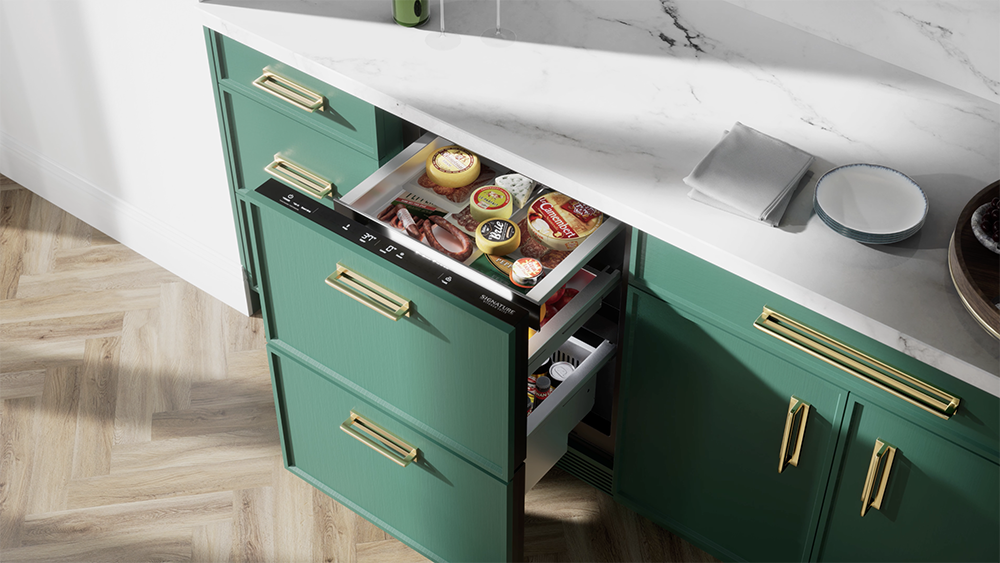
Signature Kitchen Suite Undercounter Convertible Dual Drawer Refrigerator Freezer
Even as many consumers are now venturing out of the kitchen after two years of exclusive home cooking, they are nevertheless sticking with some trends acquired during the pandemic. Experts from Almo, Signature Kitchen Suite, and Beko filled us in on what they see consumers are being drawn to, what technologies are the most popular, and where the industry is going next.
Cooking for Health (and Joy)
Health has never been so top of mind for today’s consumers, and this shows up significantly in the kitchen. Steam cooking is used for nutrient preservation, as well as retaining moisture in a recipe, and air-fry cooking gives comfort food that distinctive crispiness without using high-fat oil. While these functionalities have been around for some time, the air-fry function, in particular, is popping up most on recipe idea boards.
“Without question, air fry has become a very popular feature addition across most major manufacturer offerings,” said Jack Halperin, senior vice president, Dealer Channel Division at Almo Corporation. “The widely promoted health benefits of air frying versus traditional oil frying has propelled this feature’s popularity over the past few years.”

Beko’s 24-in. Front-Load Washer with RecycledTub
The Draw of Sustainable Appliances
Homeowners may or may not go out of their way to seek eco-friendly appliances, but when offered an easy choice, many will choose the sustainable option. That’s why manufacturers are making that choice simpler by offering appliances like the Beko Washer, which featured a RecycledTub made completely of recycled water bottles.
“Not surprisingly, what’s popular in this category are reused and recycled materials,” said Salih Zeki Bugay, director of marketing and product management at Beko Home Appliances. “[Consumers are looking for] the ability of an appliance to deliver on maximum innovation and performance without adversely impacting the planet.”
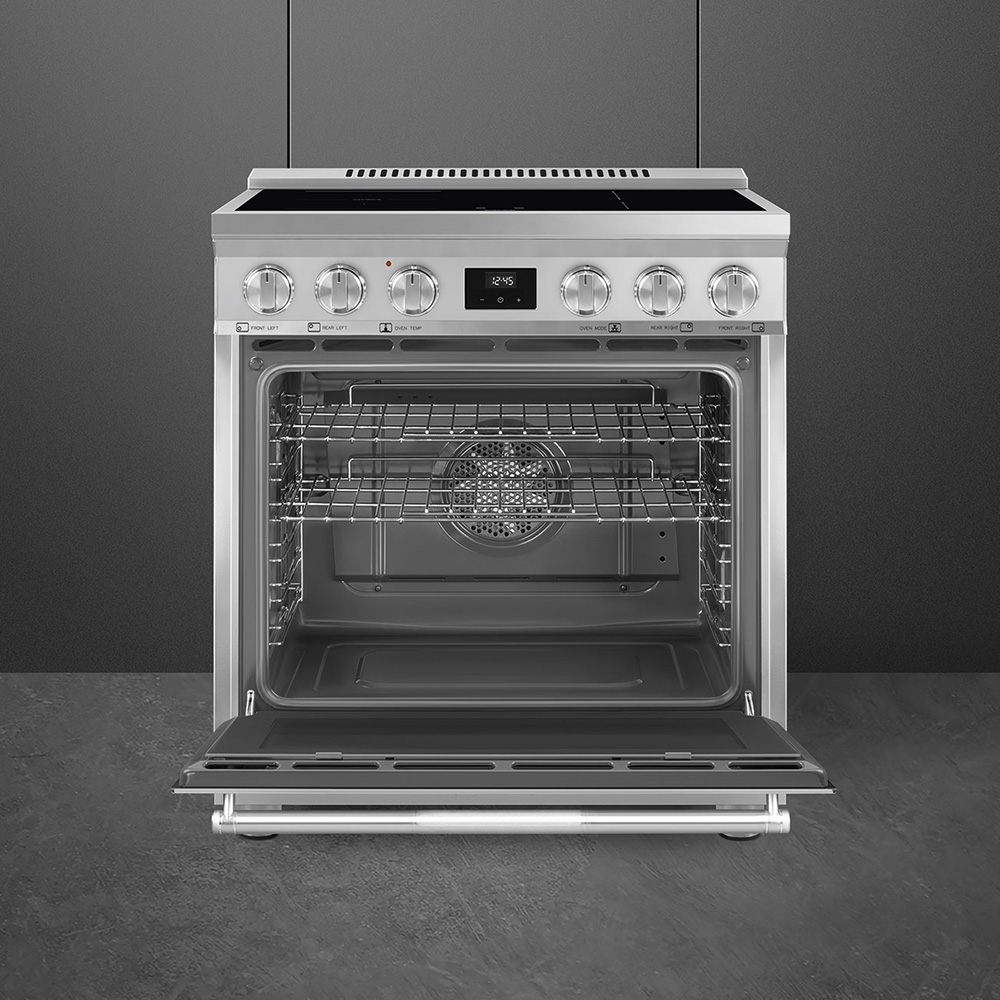
Professional Range Series from SMEG
Appealing to Busy Lifestyles
Families are back to busy and hectic schedules, so appliances that allow them to get things done faster are a commodity. “Speedy solutions for busy families encompass induction cooking, quick dishwasher and washer/dryer cycles with large-load capabilities, and quick-chill and quick-freeze compartments and options in refrigerators and freezers,” said Bugay.
According to Randy Warner, vice president of Signature Kitchen Suite, today’s at-home chefs are seeking kitchen appliances that not only deliver better results but also make food prep more efficient. “We’re seeing consumers gravitate towards products that have integrated features and functions to free up space on the countertop and create a clean, sleek look in their kitchen,” said Warner. “Plus, many of these appliances offer advanced technologies and a rich feature set.”
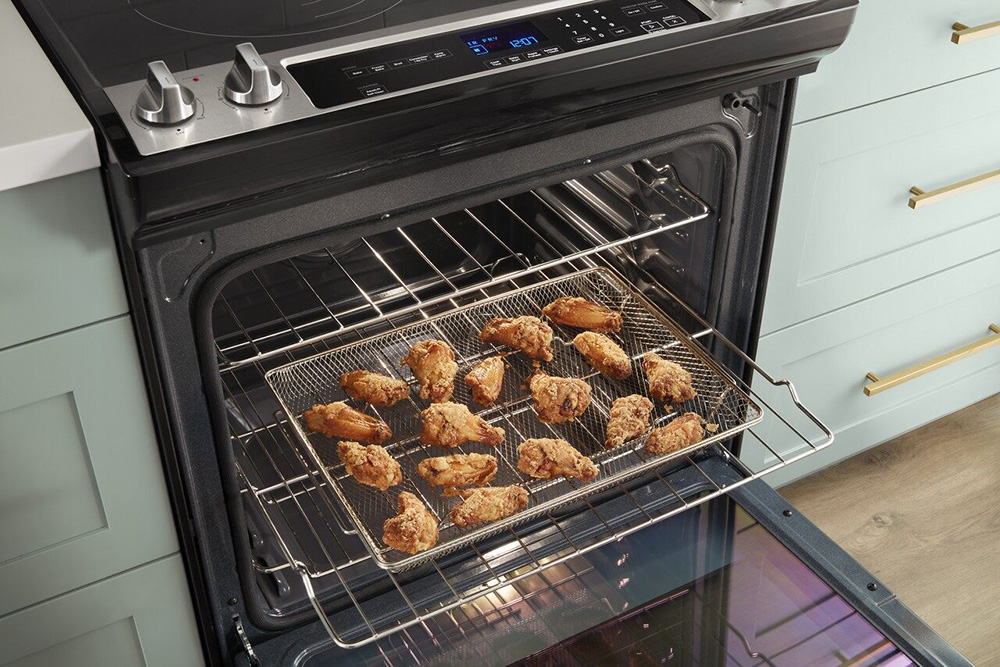
5.3 Cu. Ft. Whirlpool Electric 5-in-1 Air Fry Oven
Putting Control in Consumers’ Hands
When it comes to connected appliances, many homeowners are still on the fence, although interest is gaining. However, an appliance with self-diagnostic communication resonates well with consumers as a true headache-saving feature. “In addition, being able to begin preheating your oven from your mobile device while on the way home from work, for example, has become an easy-to-understand value,” added Halperin.
One simple solution manufacturers are using to introduce technology to consumers is offering hybrid connectivity. According to Bugay, Beko’s research shows that a sizable percentage of homeowners still want to control basic functions manually. “Connectivity is a concept that sounds great at the time of purchase,” said Bugay. “However, the realities of equipment and connection challenges, reliability, cyber security, and low customer adoption rates can limit the potential here.”
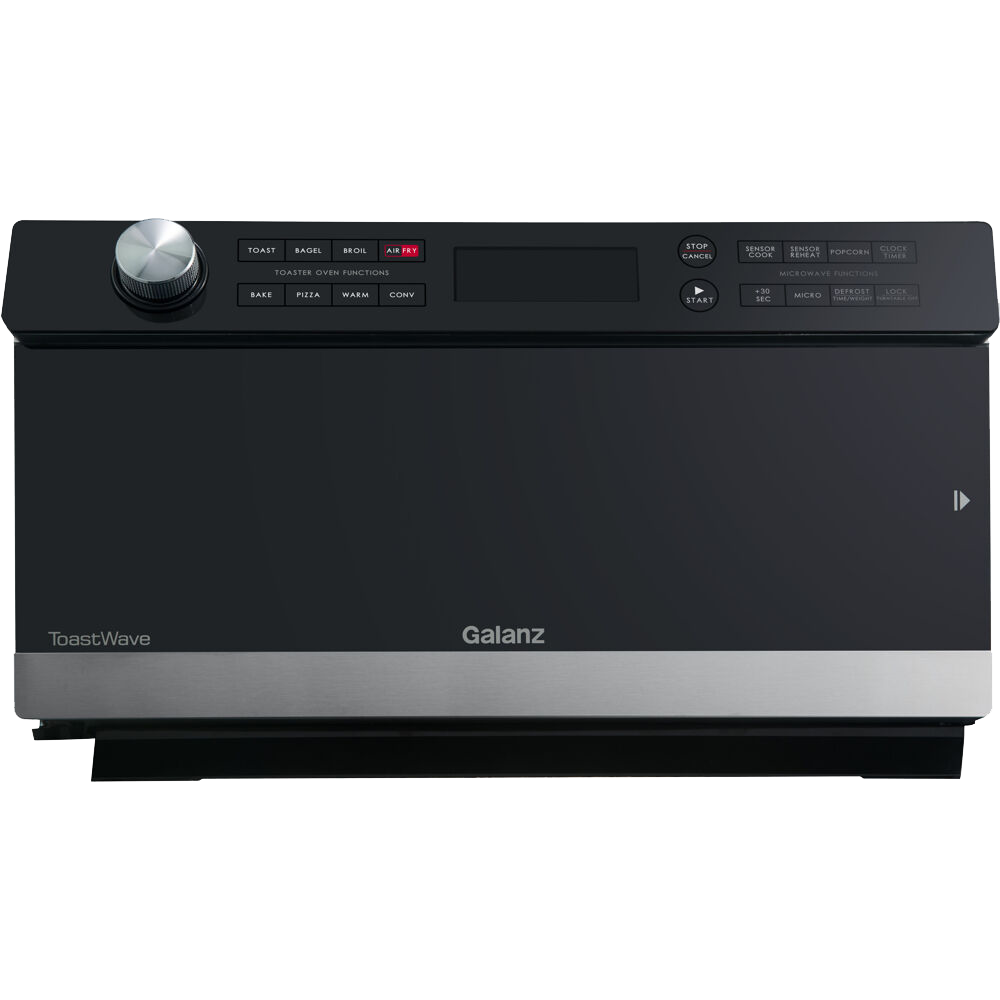
Galanz 4-in-1 Multifunctional Oven – Microwave, Toaster Oven, Convection Oven and Air Frye
What’s Coming Next for Appliances
As connected appliances slowly but surely catch on with homeowners, manufacturers are working at creating purposeful technologies that truly make lives more efficient and enjoyable. All-in-one appliances that offer more functionality and less countertop clutter are growing, healthier and often fun ways of cooking — like sous vide — are catching on, and other apps that encourage healthy eating are expanding in use.
“Connected appliance technology should continue to develop and grow in popularity,” said Halperin. “To do so, the industry has to figure out how to: convey the related benefits to the consumer in a simple-to-understand fashion that tangibly resonates with them, and how these benefits can be demonstrated to consumers during the consideration phase of their shopping experience (both on the retail sales floors and online).”
AUDIO
Sound Unbound
The third-generation Alpine F#1 Status System
produces studio-quality audio… in your car.
BY SAM HITT

Around 40 people ranging from journalists, authorized dealers, and members of Alpine’s executive management team descended on the MGM Grand in Las Vegas in February to get a look at the first complete vehicle installation of the audio company’s third-generation F#1 Status System.
The car Alpine chose to demo the audio device, a tricked-out Tesla Model S, was just as sleek as the system itself. And that’s saying something, since the Alpine F#1 Status System is the first of its kind to offer studio-quality 384kHz/32-bit High-Resolution Audio playback.
The Alpine third-generation F#1 Status System comprises six components: the HDS-7909 head unit commander, the DAP-7909 digital audio player, the HDP-H900 digital signal processor, two HDA-F900 four-channel amplifiers, and the HDZ-9000 four-way speakers. The system also includes the HDZ-9000SW 11-inch subwoofer.

End-to-End Integration
However, what makes the system unique is not the stand-alone pieces; rather, it’s how all the components synchronize to provide end-to-end integration. This seamless communication allows the third-generation Alpine F#1 Status System to produce 384kHz/32-bit level audio. For comparison, the threshold for hi-res audio is 96kHz/24-bit.
“The amplifier design is a good example. There’s nothing really crazy about the amp that we’re not doing in any of our other amps,” said Alpine Electronics of America Marketing Director Steve Brown in an interview with Dealerscope. “But, it’s the level of detail: the component quality, the design. We can take more of a traditional design and turn it into something special. It’s those kinds of little details – you know, being able to run 384kHz audio through the system – that’s probably the most impressive technical spec.”
The Hi-Fi Journey
The third-generation Alpine F#1 Status System is meant for the hi-fi audio fanatic who is looking to milk every ounce of detail possible from a track. Those looking for a system to hook their phones and stream Spotify tunes into their cars should look elsewhere.
Fully optimizing this sound system requires audio files with the highest sampling rate possible, which subjects the music to little to no adulteration from the studio original. This means running uncompressed pulse code modulation (PCM) files through the system. These files are massive since they contain much of the original details of the studio recording. When transitioned to digital files to be used in most music streaming services such as Spotify or Apple Music, that detail gets lost as the files are compressed into smaller sizes.
“In a system like this, we want all the data. We don’t care how minuscule it is,” said Brown in reference to the quality of audio the system is meant to run. “Instead of prioritizing a small file, we’re prioritizing the biggest file that we can squeeze through this thing. We are figuring out how to process it, and adding the components and the technical ability to process the whole thing.”
Finding large PCM files is rare, considering there is limited demand for them outside of the world of hi-fi audio. However, tracking down these unadulterated files from websites such as HDTracks and ProStudioMasters can be like finding a hidden gem for audio fanatics. With such a high price point, it’s clear that the third-generation Alpine F#1 Status System is being marketed toward those who are looking to extract every detail out of their music.

The Reveal
The dramatic unveiling of the souped-up Tesla came with all the fanfare you would expect from an event held at the MGM Grand in Las Vegas: free drinks, a banquet, and a veiled car just waiting for the curtain to be drawn back. However, in this instance, the quality of the product certainly lived up to the hype. The event featured a 10-minute audio demo for all participants to get a sense of the full range of the system’s capabilities. The demo also juxtaposed tracks of a lower sampling rate with detailed ones meant to be run through the system. The difference was immense.
With the highest-quality audio files, it was possible to hear even minute details such as the echo the palms of your hands make when you clap. However, my favorite part of the listening experience was when the demo played “Bohemian Rhapsody” by Queen. Each falsetto tone and beat of the drum made it feel as though I was directly in the studio with Freddie Mercury.
Takeaways
Given the intricacies of the third-generation Alpine F#1 Status System, the market for the product, which is set to retail at $35,000, is understandably niche. There are only a select few authorized dealers across the country, and each custom installed system must be tuned by a member of the Alpine team.
The Alpine team is planning on taking the demo car on a nationwide tour to allow interested custom installers, high-end audio retailers, and potential customers an opportunity to experience the system firsthand. Even if the sound system is way out of your price range, you certainly won’t regret checking it out.
Summary
- The Alpine third-generation F#1 Status System is the first in-car device to achieve 384kHz audio.
- The system is designed to run large PCM files with the highest sampling rate possible to produce the greatest sound.
- At a lofty $35,000 price point, the Alpine third-generation F#1 is aimed at a niche market and must be installed by Alpine’s exclusive list of authorized dealers.
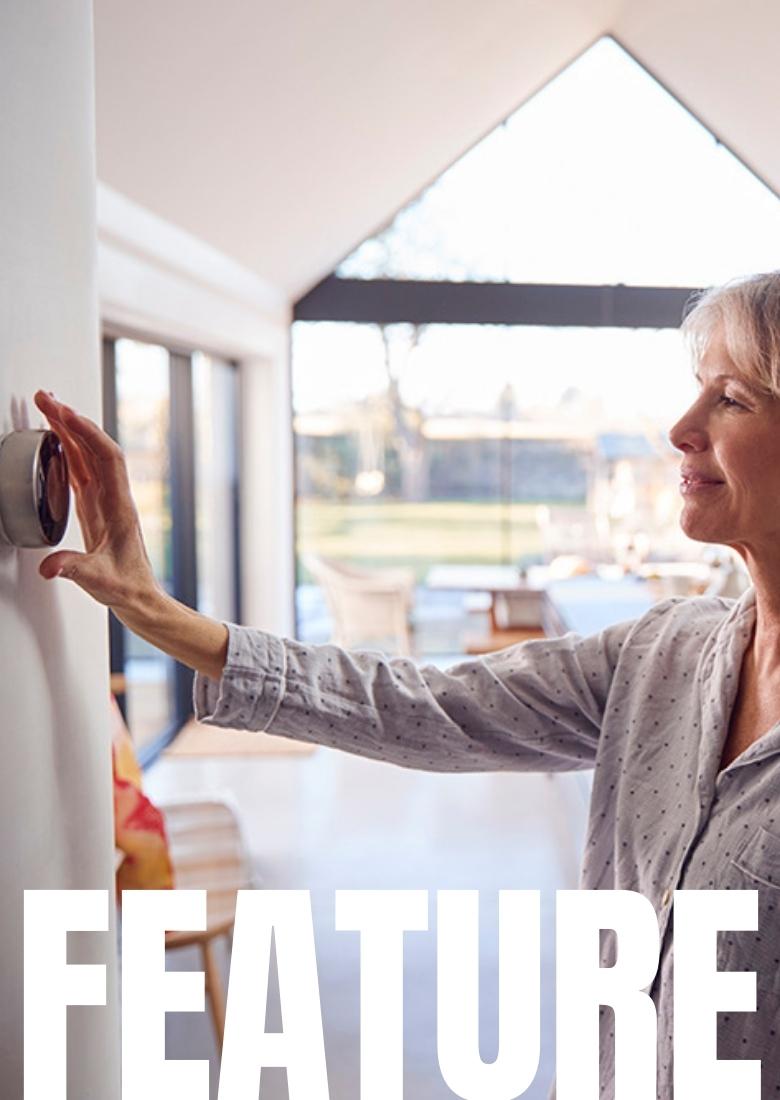
SMART HOME
Domestic Help
Smart appliances can be paths to owning the connected home, but only if consumers know how to use them.
By Jeff Unterreiner, President, U.S. Connected Living, Assurant
“Nearly half of all smart appliance owners said they did not set up connected features because they didn’t know how, they tried and failed, or they didn’t understand the wireless benefits.”
There is an emerging opportunity for retailers to grow and extend their customer relationships through sales and support of smart appliances. In fact, if done right, retailers have the chance to gain a major foothold in the consumer’s increasingly connected home.
The pandemic-fueled rise of connected product purchases and the growing comfort of consumers with using technology has opened the door for greater adoption of smart appliances. Even before the pandemic, the percentage of U.S. Internet users who own a smart appliance was expected to increase from 10.5 percent in 2021 to 21 percent by 2025, according to eMarketer, with the number of users doubling from 30.6 million to 64.0 million.
While purchasing a smart doorbell or speaker is different from buying a connected refrigerator, oven, dishwasher, or washer and dryer, the importance of providing support is the same across categories. Ease of installation, setup, and connection of these products is essential to creating a positive experience and avoiding returns.
That’s key, because since the pandemic started, 72 percent of consumers in an Assurant survey reported frustration with their connected appliances and electronics, 39 percent returned their smart home purchase due to setup problems, and 21 percent haven’t connected their product simply because they don’t know how.
Even before the pandemic, 43 percent of people who owned a smart washer and dryer said they had not set up the wireless features. Similarly, 39 percent of smart microwave owners, 38 percent of smart refrigerator owners, and 37 percent of smart oven owners had not connected their appliances wirelessly. Nearly half of all owners said the reason was that they didn’t know how, they tried and failed, or they didn’t understand the wireless benefits.
That’s likely why consumer desire for tech support has spiked in the last two years. Between 2019 and 2021, those who said they would be more likely to purchase a connected home product if it came with tech support jumped 44 percent. That was the largest increase among value-added services that positively impact purchase intent of connected products.
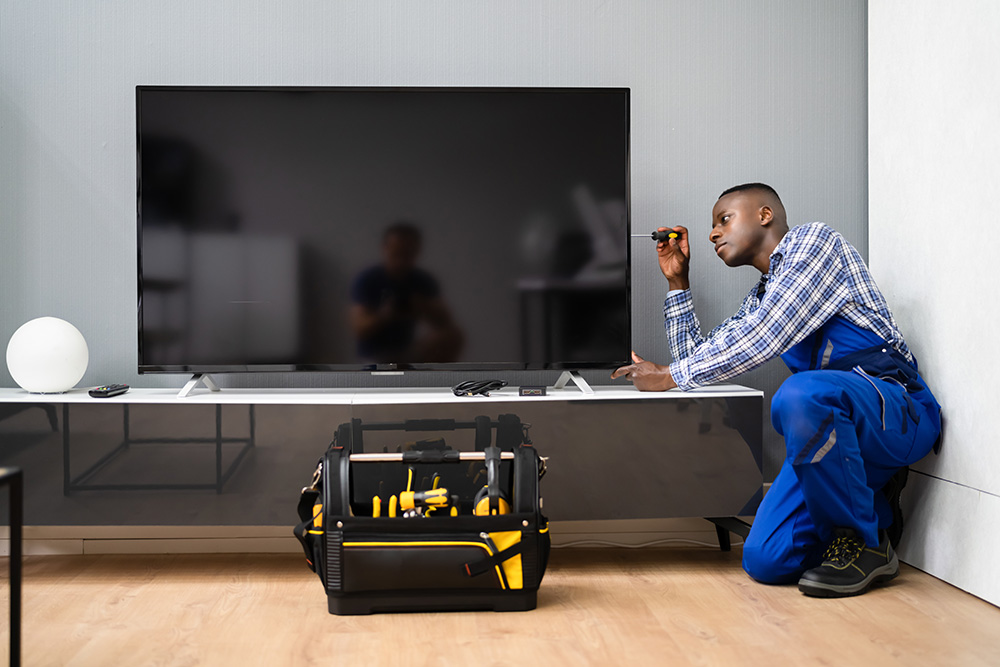
“Between 2019 and 2021, those who said they would be more likely to purchase a connected home product if it came with tech support jumped 44%.”
Clearly, retailers have an opportunity to build loyalty by helping customers set up, connect, and learn how to use their new smart appliances. Plus, support experts can run diagnostics and troubleshoot smart appliance issues remotely, possibly preventing the need for an in-home repair visit.
But why stop there? Extend the support to all the connected products in a customer’s home. Consider it from the consumer’s point of view. The average household has 18 connected devices. That can mean keeping track of 18 different tech support contact numbers and operating manuals. Who do you call when your smart washer doesn’t connect to your smartphone or Google Home?
Without a primary source for tech support, most consumers (57 percent) try to solve technical issues on their own, albeit with limited success. Only 26 percent of those taking this approach fully resolve the problem quickly and easily.
By extending tech support to all the connected products a consumer owns – even if the customer purchased the products elsewhere – a retailer can become the one-stop support source for the customer’s entire connected home. Not only would that create new and ongoing touchpoints with the customer, but it enables support specialists to provide new product suggestions that fit the customer’s home setup and offer discounts to incentivize sales.
Consider offering this type of extended tech support as part of a product protection plan. Even though smart appliances are connected devices, consumers think about them differently from a smart light or smart TV. Even with smart capabilities, appliances are still large machines with moving parts that people don’t generally expect to be able to fix themselves or over the phone.
Consumers already see more value in purchasing an extended service contract on major appliances, due to the high price points, as compared to consumer electronics. For example, 56 percent of consumers say that an extended warranty on an appliance is extremely important, compared to 46 percent on an electronic device.
Including tech support with the extended protection will enhance the value of the overall program to consumers. And once the smart appliance is up and running in the home, retailers can offer to extend the product protection to the customer’s other connected devices for an additional fee. That gives the customer one source for protection and support for their entire connected home.
Whether solving a Wi-Fi connection issue or replacing a refrigerator’s condenser fan motor, the customer wants an easy, convenient solution. Making it simple for them will lead to a better customer experience, resulting in stronger customer relationships, incremental revenue opportunities, increased loyalty, and reduced churn.
SUMMARY:
- The percentage of U.S. Internet users who own a smart appliance was expected to increase from 10.5 percent in 2021 to 21 percent by 2025, according to eMarketer.
- Even so, many consumers don’t take advantage of the connected features because they don’t know how to set them up.
- Retailers that include tech support with extended protection plans will result in stronger customer relationships and incremental revenue opportunities.

DISTRIBUTOR ROUNDUP
Roadmaps
for the Way Forward
Distributors reveal how they are strategizing in dealers’ interest to help them through what it is hoped is the winding down of the pandemic — and through all its corollary effects on both business and the supply chain.
COMPILED BY NANCY KLOSEK

What direct and indirect effects of the pandemic have impacted your business as a distributor the most of late (i.e., chip shortages, supply-chain disruptions, inflation, effects on consumer buying patterns, etc.) — and in what ways is your company adjusting the programs and policies it offers dealers to ease matters in helping them to stabilize and grow their businesses through this time?

21st Century Distributing
Mike Pote, Marketing Director/Systems
Integration Specialist
While the effects of the pandemic have had major impacts on our industry, 21st Century Distributing has found creative ways to mitigate them in each area.
From a truly unique and rewarding RoadShow/Virtual Conference Center experience to having decades-long relationships with our vendors, customers and our employees, we have been in the rare position to be able to maintain stock levels on most lines and offer an array of next-day/same-day delivery options, including 24-hour pickup, all while continuing to offer the valuable support resources our customers expect.
Our custom, mobile-friendly website is available 24/7, has live inventory and up-to-date pricing, and our customers can even work with multiple orders in their cart at once, to purchase inventory at their convenience.
The pandemic, like past world events, has taught us once again that during these events, consumers are even more likely to make improvements to their lives and the technology around them.

Almo Corp.
Jack Halperin, Senior Vice President,
Dealer Channel Division
The home appliance business, while still generally strong, continues to tackle certain challenges, which began not long after the pandemic hit full swing during CY20. Supply-chain headwinds associated with getting inventory from overseas factories to the U.S. in a timely, cost-effective fashion is still a forefront obstacle. Consistently increasing third-party less-than-truckload freight expenses (over the past 12 months) is also impacting our business as we strive to expeditiously get products to dealers.
Some of the ways we are helping our dealers include: limiting (where possible) passing on logical freight expenses; securing additional warehouse space to stock additional inventory as soon as it becomes available; and re-establishing will-call and cross-dock dealer pickup services. Our goal is to continue helping independent dealers grow and prosper, despite the current challenges.

Catalyst AV
Helge Fischer, Executive Director
The biggest issue distributors have had continues to be getting merchandise, such as A/V receivers, out to the dealers. Everyone has to be more nimble, diversify resources, and closely communicate with suppliers and customers. Catalyst AV members have always built strong partnerships, so that is really helping our members now.
Business is way up, even during this time of inflation. There may come a time, later in 2022 into 2023, where customers’ discretionary income may go in other directions. A lot depends on the war in Ukraine and perceptions in the U.S.
Suppliers, dealers, and integrators alike need to focus on forecasting, planning and business continuity, and look at all case scenarios. Our online training webinars continue to be very successful, with AVPro Edge, Cleerline and Eero; they are also recorded and put on their websites for those who cannot attend. Our members’ enhanced websites, multiple pickup locations, and offers to do site surveys and presentations for end users are also helping. Catalyst AV members are also offering extensive system design and proposal assistance for their dealers.

Climatic Home Products
Doug Allen, President
Though the pandemic is winding down, the impact is going to be long term on appliance industry. Consumer behavior has gone through a sea of change in last two years. There is much more focus on the home, and that will continue to drive the business forward.
In 2021 the supply chain was our main issue, as compressors, harnesses, and other critical components were out of sync with production demands. Currently, most critical components are available, but now the factories are struggling with back-order management and logistics challenges. Moreover, consumer demand is softening at major retail channels. One way we are managing the chaos is to smooth-out our demand signal to our manufacturing partners. A level-loaded signal and forecast ensures production flow for our channel. Finally, we are carefully watching inventory levels and are prepared to respond with promotional measures when necessary. We are also working with the independent dealer to get back merchandising floors, versus one that has what’s available..

D&H Distributing
Trevor May, Vice President, Purchasing and Vendor Business Management
The pandemic brought many challenges that caused companies to pivot their approaches. However, D&H has adapted to a roster of challenging environments over its 100-year history, from the Great Depression to the dot.com bubble and more. While the current team doesn’t span that timeframe, D&H’s agility does. We experienced an incredible technology demand cycle followed by supply shortages, supply-chain disruptions, and cost increases across the board. We focused on forecasting, inventory management, advanced ordering systems, and demand planning based on run-rate analytics to lessen the impact. We also worked closely with partners to help diversify their brands, so that if disruptions occur with one manufacturer, partners can compensate with an equally strong brand. We’ve developed a roster of supply-chain services to help our vendor partners improve logistics, and significantly increased our capacity and logistics with a new Harrisburg Distribution Center in January, which is one of six high-capacity North American warehouse locations.

DAS Companies, Inc.
Rex Berfield, National Sales Manager, CE Division
The issues have been obvious. What’s not so obvious is how differently the pandemic has impacted our dealers differently. We didn’t assume it was the same for everyone. We pushed our outside sales team to ‘hit the road’ and get the impact stories. The input was well reviewed. As a result, one immediate adjustment we made was combining our two trade shows into one Showcase Trade Show in May 2022. Strategically, our dealers will get to interact with the brands, but also, our dealers will see our full portfolio of products and all the additional product they can offer their clientele. We expect a very positive impact.

The Fesco Group
Raymond Levy, COO
We have great relationships with the global brands with which Fesco was established, and this continues to its relationships until today. We’re doing a better job of working with our brands up front to anticipate and flow-in merchandise to support the needs of our customers.
Plus, we’re both a distributor and a manufacturer. We’re doing more and more business with our own brands and licensed brands, over which we have more control.
At the end of the day, we have been fortunate enough not to have skipped much of a beat throughout this pandemic. Our vendors and customers alike have worked with us to ensure that we’re able to service everyone properly. We’re grateful to all of our partners who worked closely with us to navigate the pandemic.

New Age Electronics
Fred Towns, President
It forced us, along with most companies, to implement new ways to keep staff engaged. We had to make sure our warehouses and teams were healthy to get goods out. And we had to change how we communicate with vendors and ensure we are disseminating accurate information related to product delivery status. The taxed supply chain created a see-saw effect — product shortages would be followed by an abundance of product only to get stuck at over-capacity ports because their operators cannot load the trucks quickly enough. Being able to navigate those delays and communicate with our stakeholders has been the challenge.
To help our dealers stabilize and grow throughout the pandemic, we started doing a lot of dropship fulfillment. If our warehouses are closer to a customer than the usual route the ordered goods would take, we’ll step in to help deliver to the customer faster — sometimes leading to two-day service at standard cost.


Next Level Distribution
Jonathan Elster, CEO
The pandemic helped us understand what you can do in training and commerce from a digital standpoint. We’ve been able to do more things online, and figure out ways to train dealers. It’s created a whole new channel for us – and we’re doing trainings more often. We’ve started in-person trainings again, and they’re great, but you can do so many more digitally.
Customers do come to our amazing showrooms, but when COVID first hit, we started 24-hour pickups via lockers in self-secured rooms at all locations, making it easier for dealers to do business with us, say, if they have an install the next morning. It’s a great value-add and a convenience for them. Also, local, just-in-time delivery is available.
Supply-chain delays have affected everyone, especially in the car and home audio receiver areas, likely due to chipset issues, but we’ve been resourceful in managing categories. However, we’re still seeing strong demand. I do envision ASPs rising with a lot of new tech coming out from the TV manufacturers, and the buying patterns are a bit different this year than last.
Next Level is back on the road, in front of customers on a daily basis again, and have salespeople in every territory. Of course, we take precautions, but we’ve been very successful with these. People really want to get in front of people again; people want to see the vendors. But that doesn’t take away from the digital things we’re doing, such as driving people to the website for trainings and discount opportunities. We’re attending various trade shows and buying group shows; we’re getting in front of customers again, yet being cautious, but we still believe in the importance of interacting with them, day in and day out.


PowerHouse Alliance
Dennis Holzer, Executive Director
The PowerHouse Alliance has consistently maintained a healthy stock of products across their 55-plus member locations, but we are still not immune from the pressure created by supply-chain disruptions and chip shortages. Our members have all experienced the impacts of these issues when it comes to securing products from manufacturers. All members have increased their stocking levels when products have become available. Despite these challenges, PowerHouse members have remained a steady resource for dealers, especially for dealers who are flexible in the products they spec and offer. In addition, the Powerhouse members have increased their vendor offerings so as to at least have comparable products so the dealer does not lose their clients. Our competitive prices, rebates and rewards programs further support dealers as they navigate these tricky supply-chain waters.
Beyond helping dealers secure products, PowerHouse is also committed to helping grow the industry during these times. As home technology continues to gain popularity, the need for an additional qualified workforce to install technology in the home is more apparent than ever. This year, PowerHouse will be hosting CEDIA’s industry-leading training courses quarterly across member locations to train workers interested in joining the custom electronics installation business.


Snap One
Wally Whinna, Senior VP
During the pandemic, we didn’t have our usual schedule of events/training and couldn’t maintain our personal interactions with partners. As the pandemic’s impact decreased, we resumed our in-branch events and training that help partners develop skills and experience new product categories.
We work hard to maintain inventory on Snap One proprietary brands and have taken extraordinary measures to ensure partners have the products they need when they need them. As a result, our fulfillment rate is only slightly less than it was pre-pandemic. We have also increased stock levels and assortment on TVs and products from all our vendor partners.
Our new Partner Rewards program includes a wider range of products, including TVs and those from our vendors, making it easier than ever for our customers to earn extra discounts on purchases. Additionally, we’ve adjusted our branch freight program to make it much easier to qualify for free freight on all products, helping our partners save money and adopt a leaner inventory strategy.
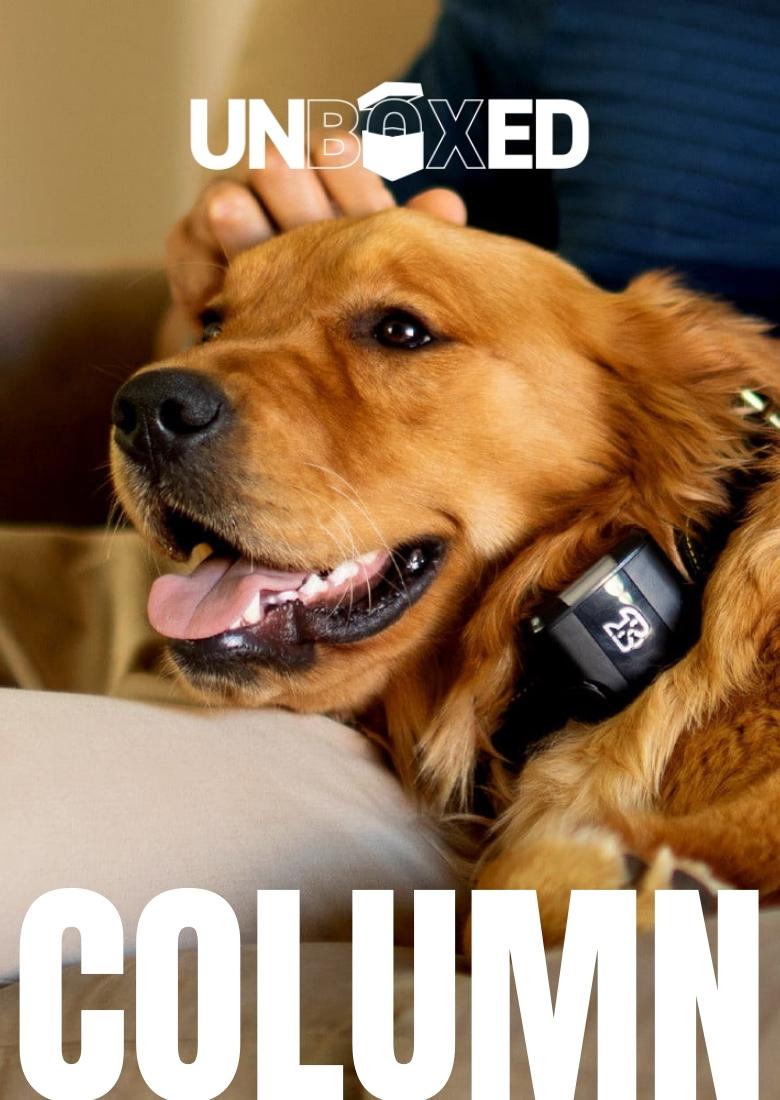

UNBOXED
Canine Correction
The Wagz Freedom Smart Collar keeps dogs in sight
even when they are way out of sight.
BY SAM HITT
Sometimes, you just come across a product that is a must-have. For some people, it’s the most recent iPhone; for others, it’s the latest and greatest hi-fi speaker from Bowers & Wilkins. However, for me, that product is the Wagz Freedom Smart Dog Collar, which features geofencing technology, health-monitoring capabilities, and a shock-free correction system. Since first hearing about Wagz during CES in January, I have been champing at the bit to get my hands on one to see if it’s capable of handling my mischievous yet adorable furry friend.
Fortunately, I was not only able to get a collar to review, but I also got to sit down one-on-one with Wagz Founder and CEO Terry Anderton, who, very fittingly, created the company in 2015 after his dogs got spooked by fireworks and ran away. Disappointed with the lack of smart collars on the market and resistant to the idea of shocking his dogs, Anderton decided to create his own device. The resulting product was the Wagz Freedom Smart Collar.
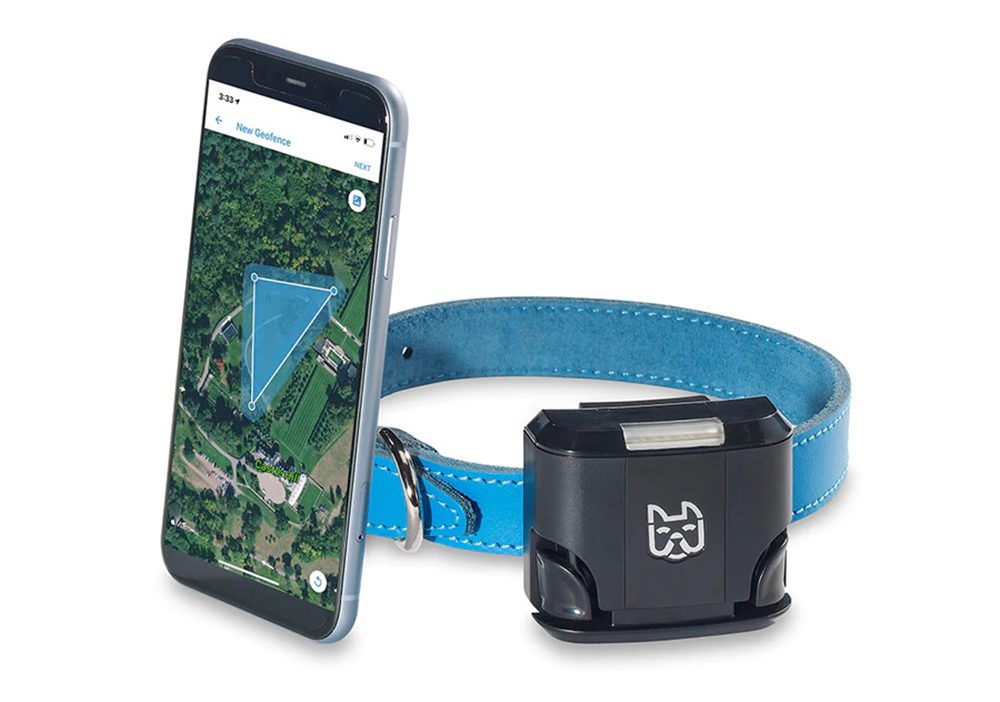

Unboxing
The first thing that stood out to me – much to my relief – was that the Wagz is attachable to any generic dog collar. All told, the Wagz Freedom Smart Collar comes with two rechargeable batteries, a charging pack, a USB-C charging cable, and a quick-start guide.
Setting up the smart collar was surprisingly easy for such a high-tech piece of equipment. Simply charge the battery, insert it into the collar, and follow the instructions on the one-page setup guide. To get going, you will be taken to the Wagz website to create an account and sign up for a payment plan, which is $99 a year, or $9.95 a month. Once those steps are complete, you will be asked to download the Wagz app and create a profile for your dog including height, weight, breed, personality traits, and daily activity habits. To calibrate the satellite tracking capability, you will have to place your collar outside in an unobstructed location for 30 minutes.
How It Works
The Wagz Freedom Collar combines an extraordinary amount of technology into one small device. It includes three different types of connectivity: Bluetooth, cellular, and Wi-Fi. The first two link the device to your smartphone while the third links the device to the cloud. Through the app, you can utilize satellite geofencing technology to create virtual boundaries, and if your pet happens to get lost, these location services also allow you to triangulate your pet’s location within a 10-foot radius.
On top of location and fencing services, you can issue behavior corrections by simply pressing a button on your mobile device. Lastly, Wagz collar acts as a Fitbit of sorts for your dog by estimating the number of steps she has taken throughout the day and the amount of time she has spent sleeping. The platform then quantifies this aforementioned data into the company’s proprietary “FIT Units” and generates a health and happiness score. When using the device, it’s important to note that it has a relatively wide margin of error, roughly 10 to 15 feet. As a result, users should take proactive steps to set the border on their app roughly 10 to 15 feet in front of boundaries which are off limits, such as roads or pools. Moreover, all the data accumulated by the device – including steps and sleep patterns – are beamed directly to your phone, providing real-time updates on your dog’s location and health status.
Behind the Scenes
On the device’s health monitoring infrastructure, Wagz features an AI platform called Cognition. In an interview with Dealerscope, Anderton referred to Cognition as “the backbone of our cloud infrastructure.” This system takes all of the data that the device collects on your dog and centralizes it on your phone with the company’s easy-to-comprehend FIT Units metric system, then analyzes it to help optimize how it interacts with dogs.
So, let’s get into the technology behind the Wagz collar. The geofencing location services are combined with a three-layer correction system – featuring vibrations, ultrasonic tones, and audible sounds – that warns your dog when it is exiting the allotted boundaries. However, if the dog does happen to leave the geofenced area, the system is smart enough to not shock them upon re-entry. The collar features an ultrasonic emitter for the correction system and Bluetooth capabilities for when you are nearby. The device also features a SIM chip so that you can stay up to date on your dog’s geolocation if they run away; however, operating via cellular data burns through the battery at a much quicker rate. As it stands, on a full charge, one battery will last 12 to 24 hours on a dog who spends most of its time in the house and six to eight hours for the most active dogs.
“Your old-fashioned shock collar that is still being sold today by big-name companies shocks the dog when they break through and then a second time if they try to come home because it doesn’t have any intelligence about the location of the dog,” said Anderton. “However, with vibration and ultrasonic, it works on the dog’s behavior. It doesn’t hurt them but they don’t like the sensation and they know they want it to stop.”
Hands-on With Dog
My roommates and I have a two-year-old rescue named Cash, a 30-pound Lab-Terrier mix who has a special talent for breaking rules the second she sees an opening. I had high expectations for this product, but I knew that before I could hop on the bandwagon, I had to run it through Cash. Typically, when Cash is getting up to something she’s not supposed to, she will ignore any command to the contrary until you are inches away. Her bad behaviors are headlined by her ability to bump the trashcan lid up with her head and shove half her body down into it in a way that defies physics.
The corrective technology in the device certainly did its job. The first few times I gave her a correction for going into the trash can, she ran around in circles trying to figure out where the vibration and sound were coming from. Now, she has gotten used to it enough that when I initiate the correction, she knows she’s done something wrong and immediately evacuates the scene of the crime. Cash is a massive wimp. She yelps like a turkey anytime we try to cut her nails or bathe her; so her lack of yips when corrected by the collar lets me know that she isn’t feeling any pain. One qualm I have with the correction technology is that there is a roughly two-second discrepancy from when you initiate the correction on the phone to when it is received by the collar.
In regard to the geofencing capabilities, I wasn’t able to put it through the gauntlet daily since my backyard is only about 10 to 15 feet wide in total. However, I have to say that getting up-to-date information on her step count and walk patterns was enlightening for me as the owner, since it allowed me to see just how active she is over a day.
Bottom Line
Overall, the Wagz collar is great and the geotracking technology is surprisingly accurate. Sometimes I would leave her out in the backyard and check her geolocation on my phone and it easily narrowed her location down to the exact section of our tiny yard she was in.
My biggest pet peeve with Wagz device is the battery run time. I fully understand now why the company includes two batteries with the product instead of just one. On Cash, each battery on full charge lasted maybe six to eight hours, if I am being generous. It feels as though I am constantly having to charge and replace the battery once or twice a day, which just doesn’t feel sustainable. Overall, in the next generation of this device, I hope the company will deliver a battery that can sustain the collar for two or three days on one charge.
However, I think this is a quality product that will draw a good amount of consumer attention at its given price tag of $249 for the device and $99 for a yearly subscription. By comparison, other smart collars on the market such as the Halo 2 will run consumers close to $700.
At CES, the company also announced that it will be releasing a product called Wagz Tagz, a tile-sized device that you can stick on an object such as a trashcan to keep your dog from going near it. When the dog gets too close, the Wagz Tagz triggers the correction technology in the collar. The rough release for the Wagz Tagz has been set for Spring 2022, so keep your eye out. I know I will.
SUMMARY:
- The Wagz Freedom Dog Collar combines the utilities of ainvisible fence, a training collar, and a Fitbit for your pet, all into one device.
- A corresponding mobile app lets dog owners set invisible boundaries, issue corrections, monitor health data, and get real-time location updates on your pet.
- Though it comes with a spare battery, the canine wearable requires a charge or battery charge more than once a day to keep it operational.
SPECS:
Name: Wagz Freedom Dog Collar
Category: Pet Tech
Weight: 1.7 oz
Battery Life: 6 to 24 hours (with additional batteries)
Price: $249 for device, $99 annual subscription
Website: wagz.com
ADVERTORIAL: ACCESSORIES TRENDS
Consumers Emerge from Pandemic More Knowledgeable About What Electronics They Need


By FRED TOWNS, PRESIDENT, NEW AGE ELECTRONICS
As COVID numbers trend in the right direction, companies and consumers are braving travel again. Coupled with the move to hybrid office and continued remote work, people are connecting from anywhere. At home, connected devices and applications are growing in popularity because of remote work. Hands-free communication, entertainment and monitoring are a few benefits that prove smart homes’ staying power.


Shokz OpenComm UC is a headset for unified communication designed for a better work experience – at the office or at home. It is PC compatible and works with major communication platforms such as Zoom, Teams, Skype and more. Designed to deliver superior communication, clarity, and a seamless user experience while not compromising on situational awareness.
Tablets prove their value at home and on-the-go
While tablets declined with growing mobile phone screen sizes, the pandemic brought on a resurgence as consumers discovered new applications for tablets. Today, more tablets are being shipped than desktop computers. Retailers should be prepared to offer a range of products to fit consumers’ needs. Optimized screen resolution, memory and battery life are a few factors that have attracted consumers back to tablets. Today’s tablets show vastly better performance, such as the Amazon Fire 10 Tablet with 3 GB of RAM and an octa-core processor.
Many tablets on the market have been optimized for productivity and entertainment, and travelers are finding them increasingly indispensable. Passengers who want in-flight entertainment will need to adopt a BYOS protocol (‘S’ for screen), as some airlines have replaced screens on seat backs with tablet holders.
Productive travelers who want to continue working at 30,000 feet can use in-flight connectivity from their tablet. As in-flight connectivity grows, remote workers will be accustomed to being perpetually connected.
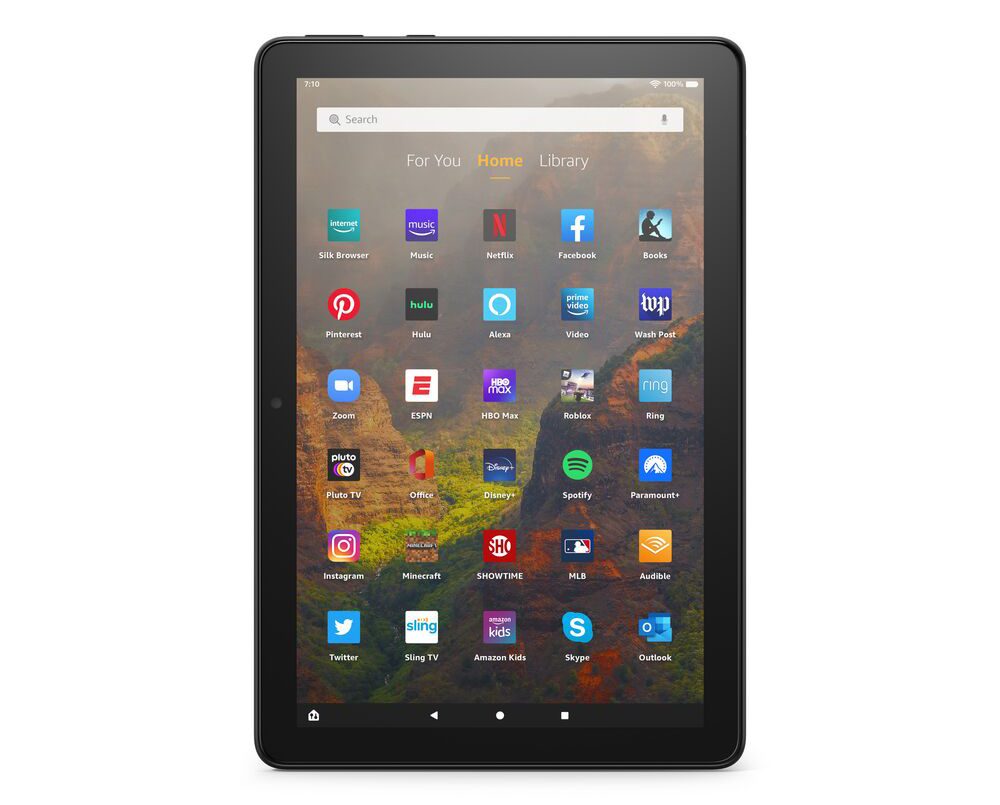

The bright, fast, and responsive Amazon Fire 10 Tablet is a great on-the-go product for resellers to stock. With a vibrant 10.1” 1080p Full HD display and powerful performance, consumers can enjoy up to 12 hours of reading, browsing the web over Wi-Fi, watching videos, and listening to music from anywhere. It’s also durable, engineered to hold up against everyday life.
Audio to play increasing role in workplace gatherings
Corporate and social gatherings are bouncing back to pre-COVID levels. Business meetings and conferences are returning to physical spaces, and consumers will expect to have connected, reliable audio to help make attending and conducting multi-media events more seamless. Noise cancelling ear buds help workers quietly focus on work between conference sessions or meetings. Those with near-range sound amplifiers help users discern conversations in crowded environments. They can then transition to a virtual meeting or call to update those back at headquarters or check in with family.
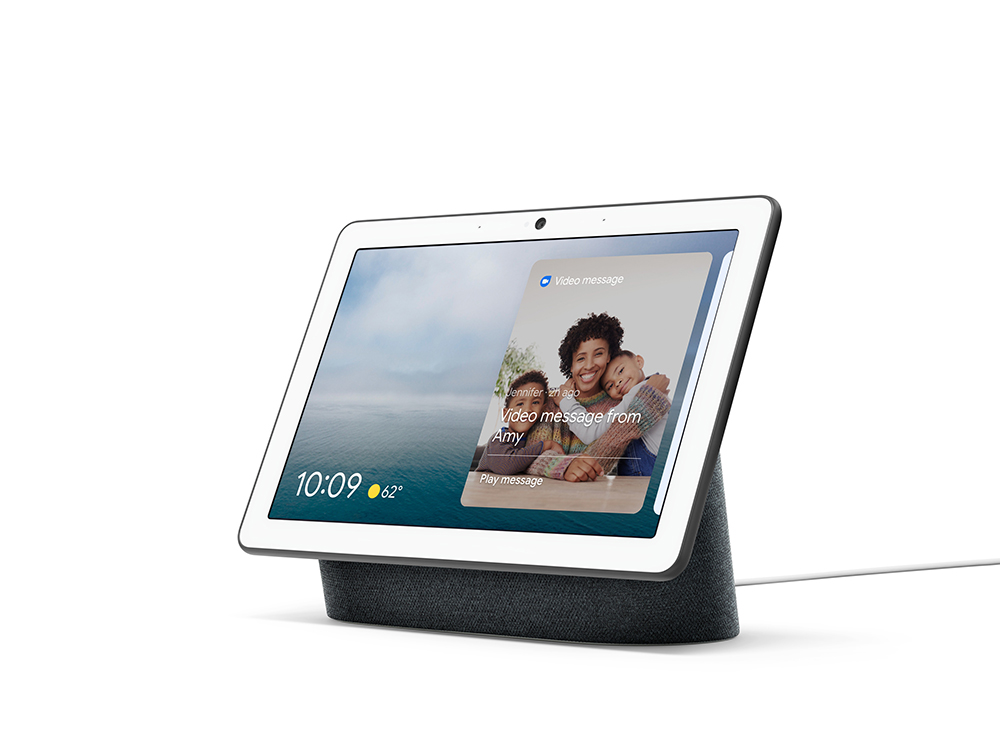

Google’s Nest Hub Max helps busy families stay in touch and on track. With a Google Duo account, users can leave video message and make video calls. They can see their own calendar, community, and more with enrollment and setup. Its 10-inch HD screen and stereo speakers provide high quality sound and entertainment.
Home office to stay (the good parts)
The pandemic brought about behavior changes likely to stay with us. While home offices existed before 2020, their growth during the past two years and adaptability of the office worker shows they may have staying power.
With the rise of the remote worker came the need for more connected homes – smart doorbells, security systems, home entertainment, and communications.
Smart home hubs like the Google Nest Hub Max is one example that enables residents to perform a number of functions, such as making video calls and displaying a security camera feed.
Consumers will carry the best of their pandemic adaptations into the post-pandemic world and have a strong grasp of what they need to carry out their lives at work and at home.
After having lived and worked through the challenges of the pandemic, consumers now have a firm grasp of what solutions they need to create their ideal work environment – whether a permanent workstation or a few key electronics that move with them. Retailers should be able to advise consumers on the array of options that fit their needs, factoring in mobility, versatility, comfort and productivity.



FRED TOWNS,
PRESIDENT,
NEW AGE ELECTRONICS


E-COMMERCE
The Low-Hanging Fruit
of E-Commerce
Three ways to maximize online sales in 2022.
BY JOHAN LILJEROS
Consumer electronics make up the largest share of all U.S. retail e-commerce sales, accounting for 22 percent of all e-commerce sales nationally. And, consumer electronics are projected to bring in over $79 million in ecommerce sales in 2022. Consumer electronics retailers should seize the opportunity to optimize their websites to capture a greater amount of ecommerce sales and market share to capitalize on these upward trends in 2022.


Focus on the Fundamentals
There may not be enough time to add new, exciting features or implement new payment and delivery options, but one area that retailers can focus on is fixing the fundamentals. This can have a significant impact on sales performance in the new year.
When it comes to the fundamentals, three things should be considered: site performance, customer experience, and business processes. Getting these areas right is crucial to sustained ecommerce success. Let’s look at each one.
1. Site performance
Consider what would happen if your online store was unavailable for as little as one minute. While traffic varies for every retailer, looking at some generalities, it can mean losing around 1,200 visits and 325 orders; with an average order value of $300, that means over $105,000 in lost sales for every minute of down time.
But there’s even more at stake; a poor first-buying experience almost always impacts a customer’s willingness to return. So, on top of lost sales opportunities, each one minute of downtime during the holiday season can be extrapolated to include loyalty loss (visitors experiencing down time can be considered lost long-term) and customer acquisition loss (lost return on investment of marketing dollars spent on driving traffic to your site during that down time).
Long story short: Make sure to test your site performance thoroughly, well before the holiday shopping season begins. It is better to have your site fail when you have 0.3 orders per second than 5.4 orders per second.
2. Customer experience
Consumers today expect the same level of service and convenience online as if they would walk into a brick-and-mortar store location. Customers who experience a seamless and convenient buying journey are more likely to become loyal to that brand and come back for repeat purchases.
When it comes to customer experience, every step of the buying journey should focus on convenience and simplicity. Customers should easily find what they’re looking for, and checking out should be like a playground slide – they should be done and gone quickly and easily.
There are many analytics that you should be looking at to understand how customers browse your site. But at this late stage you should complement this with qualitative research to identify any last-minute site-optimization needs. Identify your “target buying persona” in your customer database and consider offering them a 50 percent discount on one order in exchange for input on what they find frustrating or annoying during the shopping journey. This is an easy and cost-effective way to get feedback that can go a long way toward refining your user experience.
3. Business Processes
Walk through your business processes related to every step of the buying journey. Identify where you are dependent on external partners and systems. Be sure to load-test not only your ecommerce site but also supporting systems, such as payment engines, customer support ticket systems and order management systems to ensure they can scale and handle the volumes you anticipate.
Study your process flow charts in detail and identify any steps that can be removed or accelerated to optimize the customer experience. Can you speed up the curbside pick-up process? Add dynamic content to your customer service FAQ? Fine-tune order packaging?
Looking and Thinking Ahead
For consumer electronics retailers, getting the new year off to a strong start is a recipe for success. Fine-tuning your ecommerce site is a chance to heavily increase the number of customers in your database and build customer loyalty for a solid revenue stream and healthy returns in 2022.
Johan Liljeros is General Manager and Senior Commerce Advisor, North America, at Avensia and Johan Sommar is Chief Strategist at Avensia.


BABY TECH
Adventures
in Baby Tech
Gadgets to help parents take care of their newborns
have expanded beyond monitors.
By EGON SANDERS
A growing number of products have been developed in recent years to help new parents deal with the stress, anxiety, and sheer struggle of having a baby. Reliable and effective baby monitors continue to be the most essential pieces of kit for new moms and dads: In addition to video and audio monitoring, the ability to track other data points like movement, temperature, and heart rate is becoming increasingly common in the category. Wearable breast pumps, sleep lights, and connected gadgets of all stripes have become common tools in the parenting toolshed. Having a baby brings with it an inevitable degree of chaos. These days, technology can help mitigate some of this chaos — or, at least, make it more predictable.
Monitoring
Baby monitors are the most crucial piece of modern parenting tech. There are quite a few on the market now, with a number of different features. The Nanit Pro ($300) is one of the best: It can be wall-mounted or set up on its stand, and records a 1080p video stream that’s clear in the light or the dark, which can be shared with multiple caretakers. Everything happens via the smartphone app, which means there’s no need to worry about a dedicated display. It offers noise and sound alerts, takes snippets of the baby’s nighttime activity, and tracks its sleep data. The included Breathing Band even lets parents track their baby’s breaths per minute with no electronics or batteries involved: The camera tracks the unique pattern on the band to detect the baby’s breathing motion from any position in real time, and can send you alerts if something is off.
The Owlet Dream Duo ($400) pairs its 1080p video stream with its patented wearable Dream Sock, which tracks key sleep quality Indicators like heart rate, oxygen level, wakings, humidity, room temperature, and noise level. In addition to peace of mind, this data stream is designed to help provide parents with a better understanding of their baby’s sleep habits and sleep quality, which are all managed via the Owlet Dream App (where you also monitor the video stream).
Lastly, a number of baby monitors use radio signals to transmit the video signal from the camera to the included display. The Eufy Spaceview Pro Baby Monitor ($170) is one of them: Using wireless FHSS transmission provides a secure, private stream that’s not susceptible to someone hacking the Wi-Fi, and is impervious to the Internet going out. The camera pans 330 degrees to see the room from corner to corner, and tilts 110 degrees to see floor-to-ceiling, and the wireless range coverage is up to 1,000 feet. The best part? It works straight out of the box with no app, pairing, or software tweaking required.
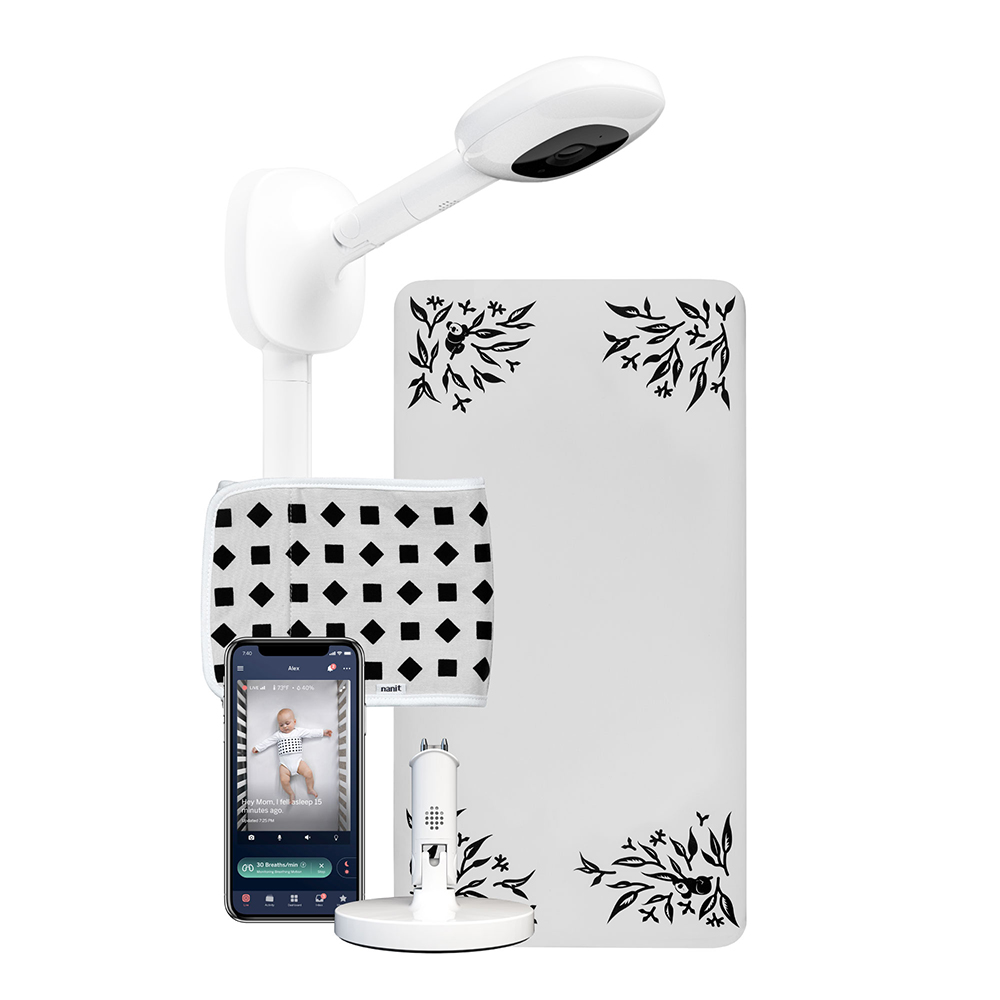

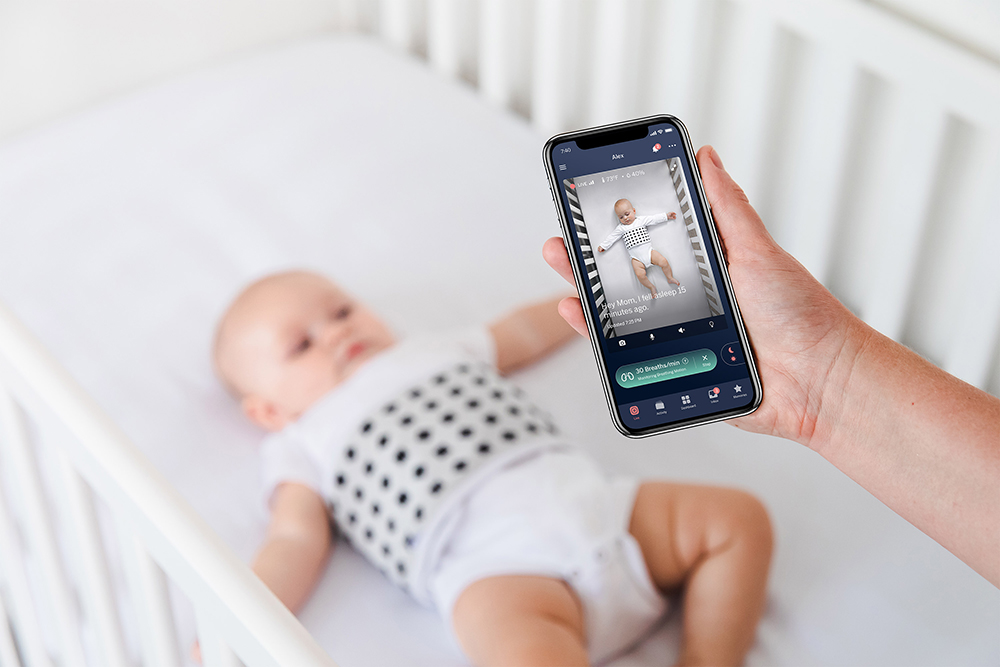

The Nanit Pro ($300)
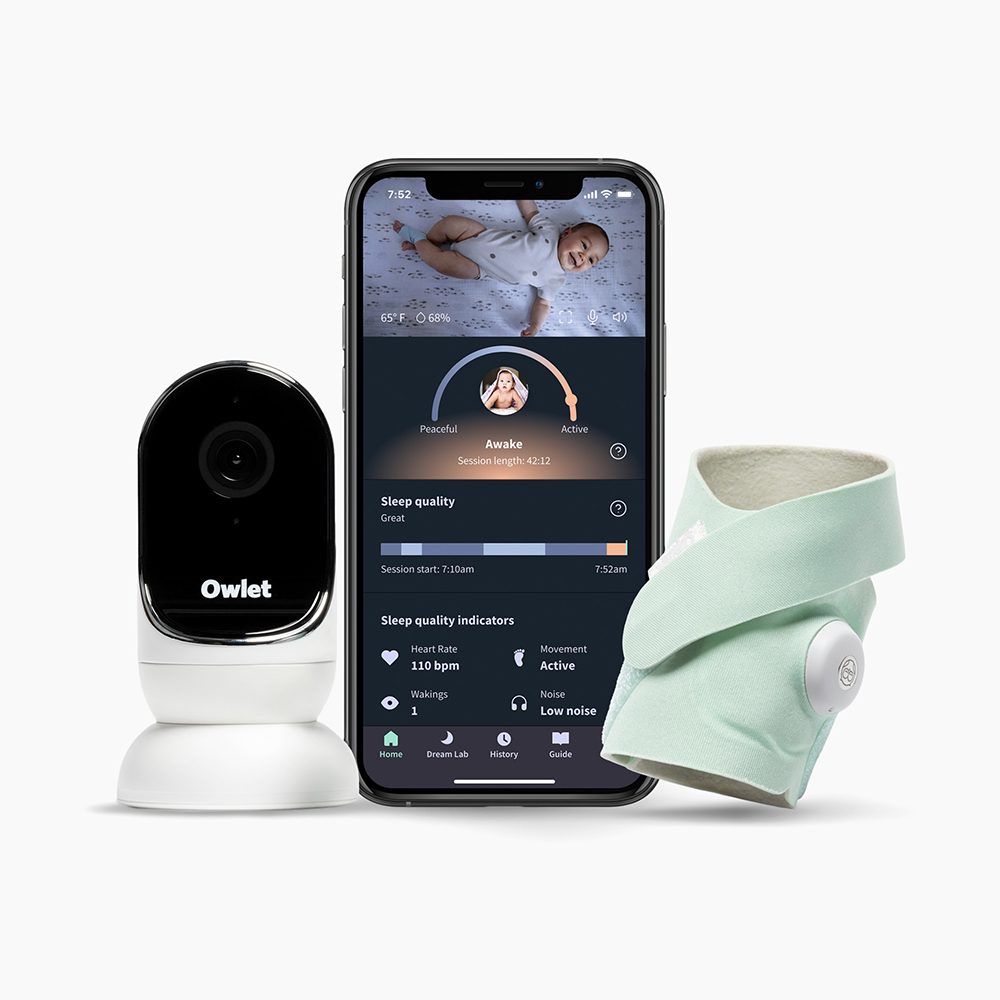

Owlet Dream Duo ($400) pairs its 1080p video stream with its patented wearable Dream Sock
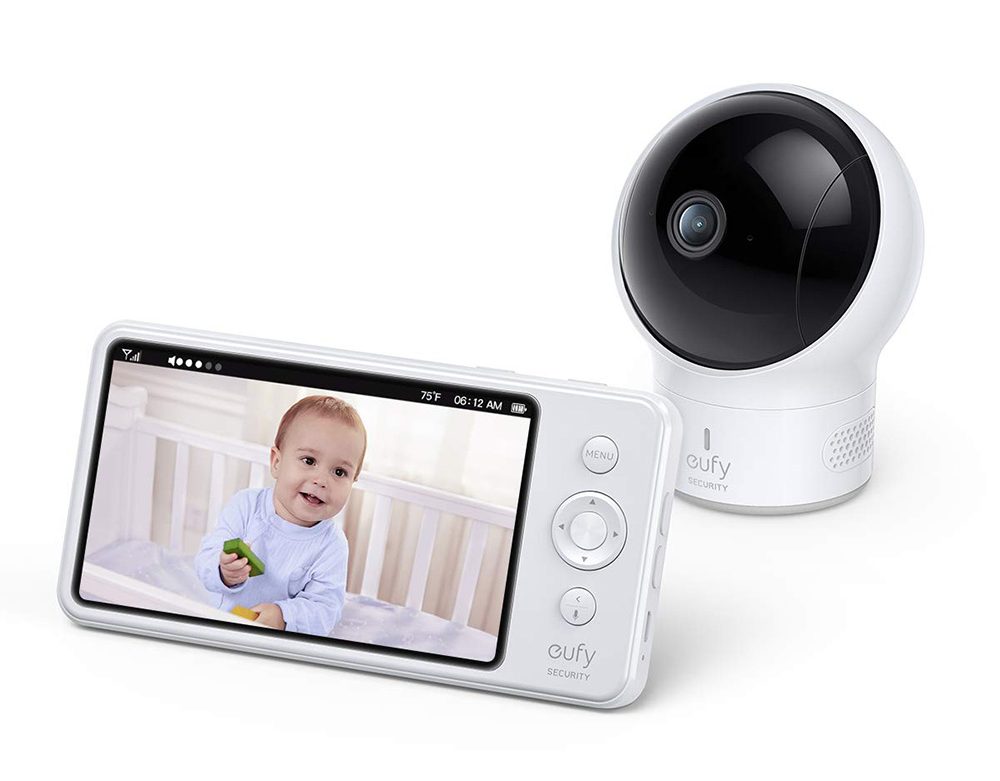

The Eufy Spaceview Pro Baby Monitor ($170)
Sleeping
There are a number of sleep machines out there, but few are as well-executed as the Hatch Rest+ ($90). In addition to 11 soothing sound themes and a customizable, full-color night light, Hatch’s Rest+ also includes a two-way audio monitor, a backup battery (for storms or short naps), and Amazon Alexa integration. This whole suite of functionality is controlled via its dedicated iOS/Android app, which allows the user to set up one-touch programs for bedtime, nap time, and wake-up time. Babies love routines, and Rest+ is a great way to help instill them.
A high-tech bassinet, the Snoo ($1,595) is full of tricks. To get your baby to sleep (and keep them there), it has three microphones, a speaker, and two motors that create different rocking motions. Swaddle the baby in one of the Snoo’s sleep sacks and clip the sack into the sides of the bassinet, and then start the Snoo, with either the push of a button or via the Snoo iOS/Android app. The bassinet begins its gentle rocking motion and plays white noise; if the baby starts to fuss, the mics will pick up the baby’s crying and trigger the motors to increase the movement, and change the frequency of the white noise. Once the baby is comforted, the Snoo will slowly decrease to the initial level. If the screaming reaches a certain intensity, the Snoo shuts down and sends you a notification that your baby needs you.
Something of a mechanical bull for soothing your baby, the 4moms MamaRoo Multi-Motion Baby Swing ($240)bounces and sways with five different motion styles and an equal number of speed options. This movement is combined with four built-in sounds (or with any connected audio device with a 1/8-inch headphone output); your baby can be positioned anywhere from a sitting position to a full recline. It’s available in three fabric options, all of which are removable and, thankfully, machine washable.
For those looking for a more affordable way to rock their baby to sleep than either the SNOO or the MamaRoo, the under-the-radar Sleepytroll ($170) is a rechargeable mechanical baby rocker that can be attached snugly to essentially any stroller or bassinet. It has built-in motion and sound sensors to trigger itself to turn on when your baby is restless, and can be set to a number of different intensity settings that work for your baby.


Hatch Rest+ ($90) with 11 soothing sound themes and a customizable, full-color night light.
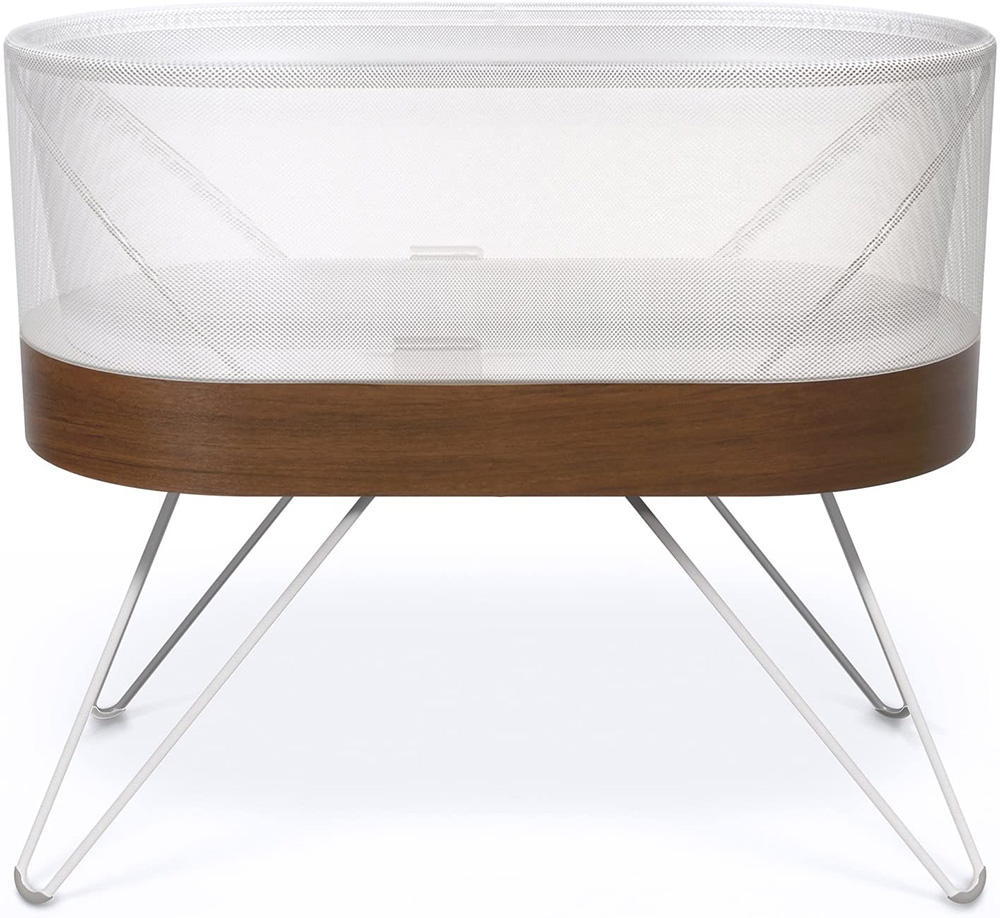

Snoo ($1,595) is full of tricks. To get your baby to sleep (and keep them there), it has three microphones, a speaker, and two motors that create different rocking motions.
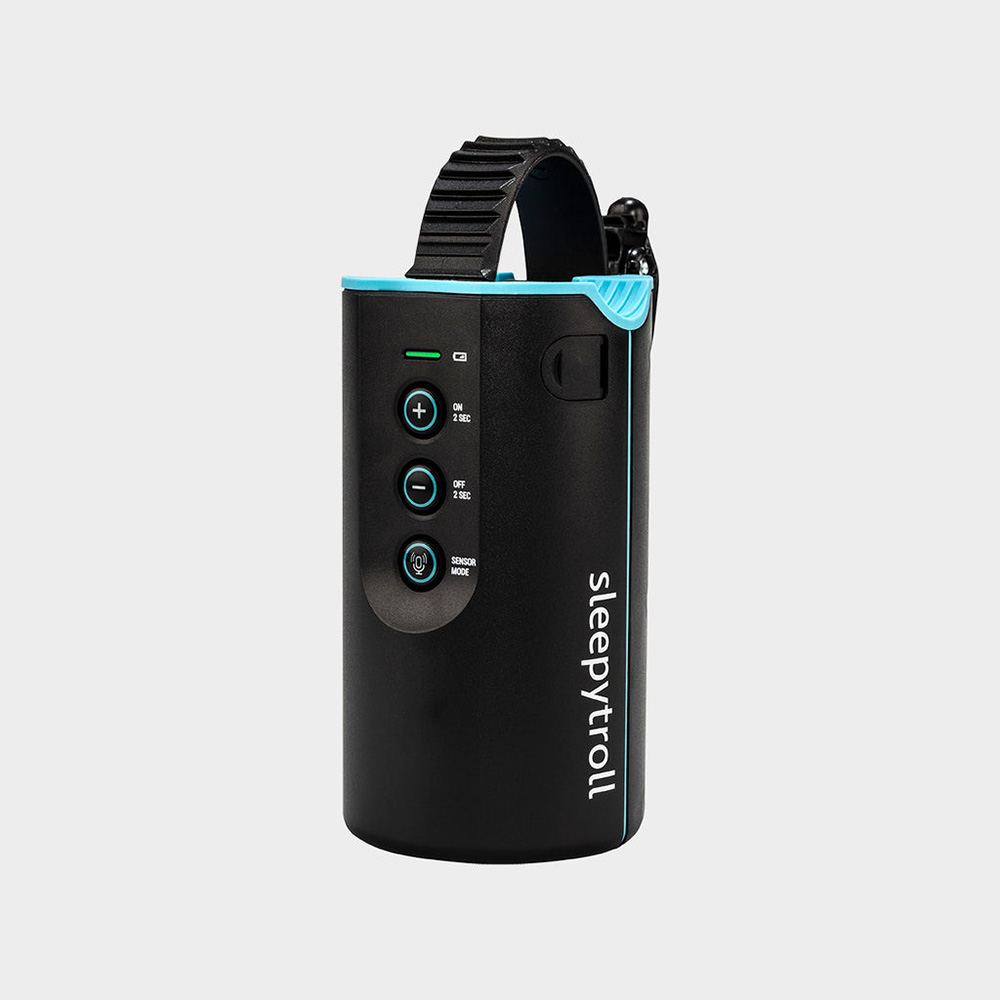

Sleepytroll ($170) is a rechargeable mechanical baby rocker that can be attached snugly to essentially any stroller or bassinet.


4moms MamaRoo Multi-Motion Baby Swing ($240)bounces and sways with five different motion styles and an equal number of speed options.
Feeding
Keeping a baby fed is a lot for any mom, so a tool that can help make breastfeeding more convenient is worth its weight in gold. Willow ($500) is very much part of the wearable tech trend: Instead of being tethered to a typical breast pump, this spill-proof, egg-shaped device slips into a bra, and can even be worn under the shirt. This allows mom to pump while working, doing stuff around the house, or soothing the baby. It lets the user control the intensity of the pump (either on the pump itself or via the smartphone app), and automatically tracks and logs the pumping sessions, to boot.
Eventually, babies graduate to eating solid foods, and having an easy way to cook those foods without firing up the stovetop can be a lifesaver. Essentially, the BEABA Babycook Neo Homemade Baby Food Maker ($250) allows parents to quickly steam-cook and blend raw ingredients into freshly cooked baby food. The fact that it uses steam cooking means you can avoid using oil, while also retaining the nutrients that are lost even when boiling. Designed and made in France, it’s a surprisingly good looker on any countertop.


Willow ($500), spill-proof, egg-shaped breast pump
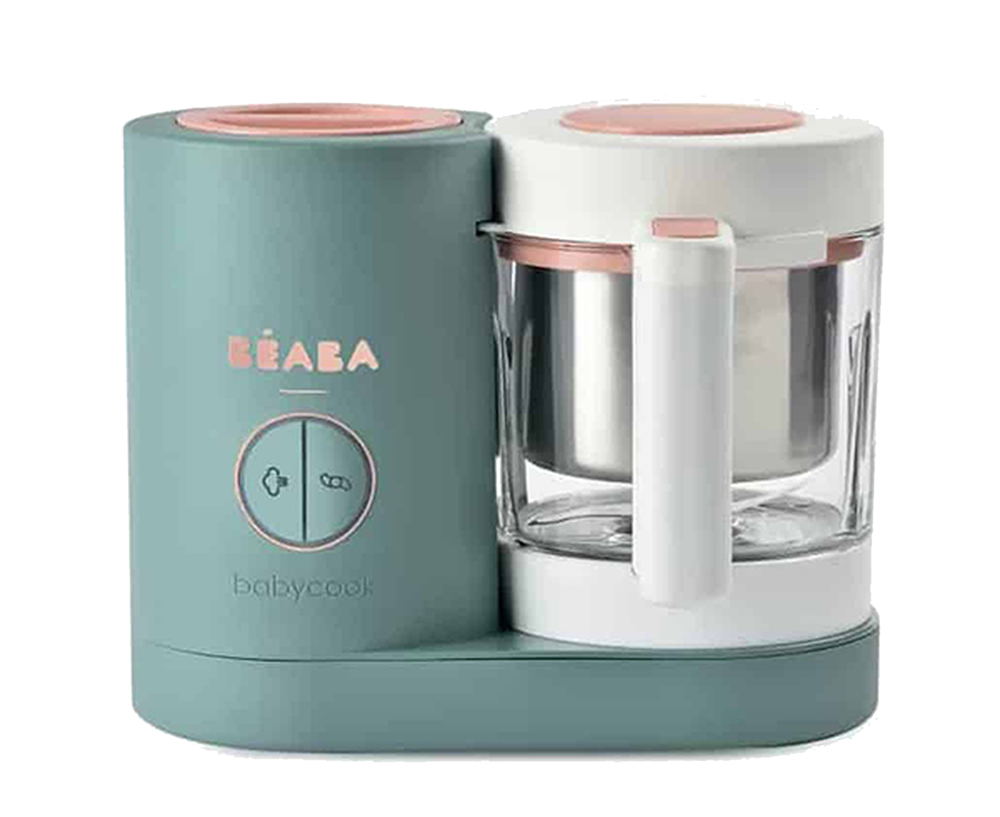

BEABA Babycook Neo Homemade Baby Food Maker ($250) allows parents to quickly steam-cook and blend raw ingredients into freshly cooked baby food.
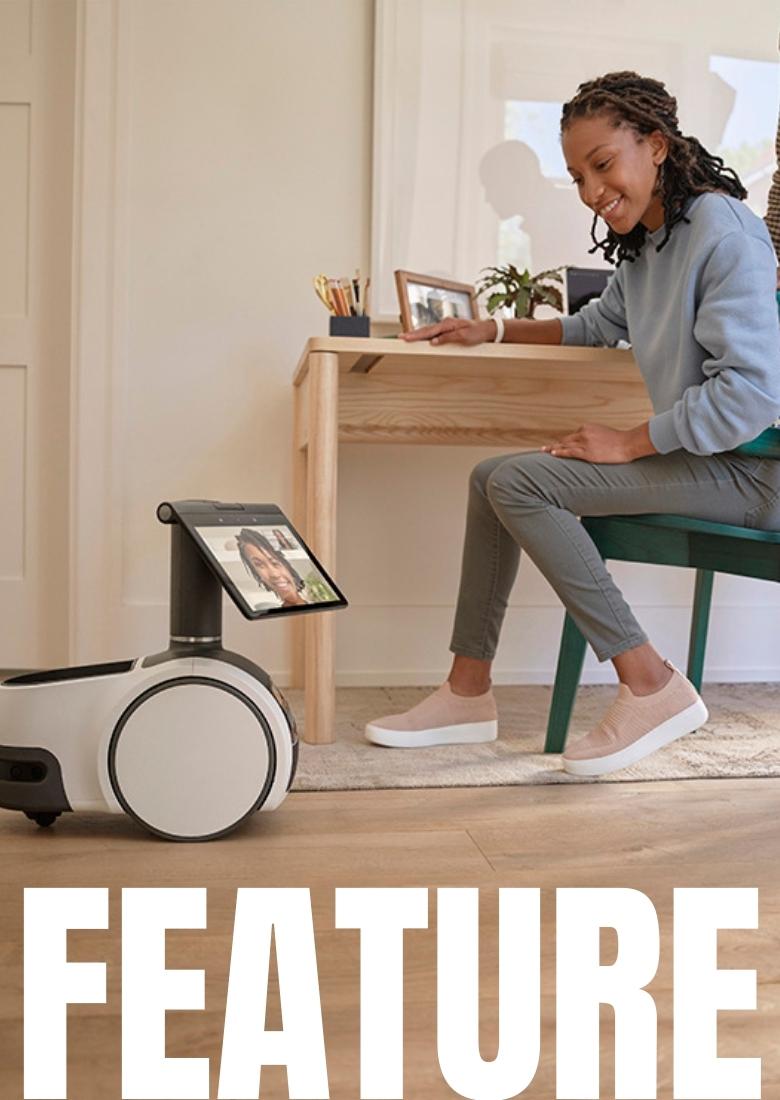

ROBOTS
Robots For Sale
From cleaning your windows and mowing the lawn to keeping tabs on pets and teaching kids, domestic jobs are increasingly doable by off-the-shelf consumer robots.
By EGON SANDERS
The presence of robots in our domestic lives has come a long way since the Roomba first entered the scene some 20 years ago. As AI and machine learning technologies have continued to advance the underlying technology, physical machines of all shapes and sizes have become increasingly common in our homes, cars, yards, and pools. While big tech companies are in on the action — think Amazon’s Astro, announced last year — many of the most interesting developments are coming from smaller, more focused and agile startups. We’ve gathered together some of the most exciting propositions in modern consumer robotics, which are slowing taking over many of the tasks we’d frankly rather not do — and, hopefully, not destroy human civilization as we know it in the process.
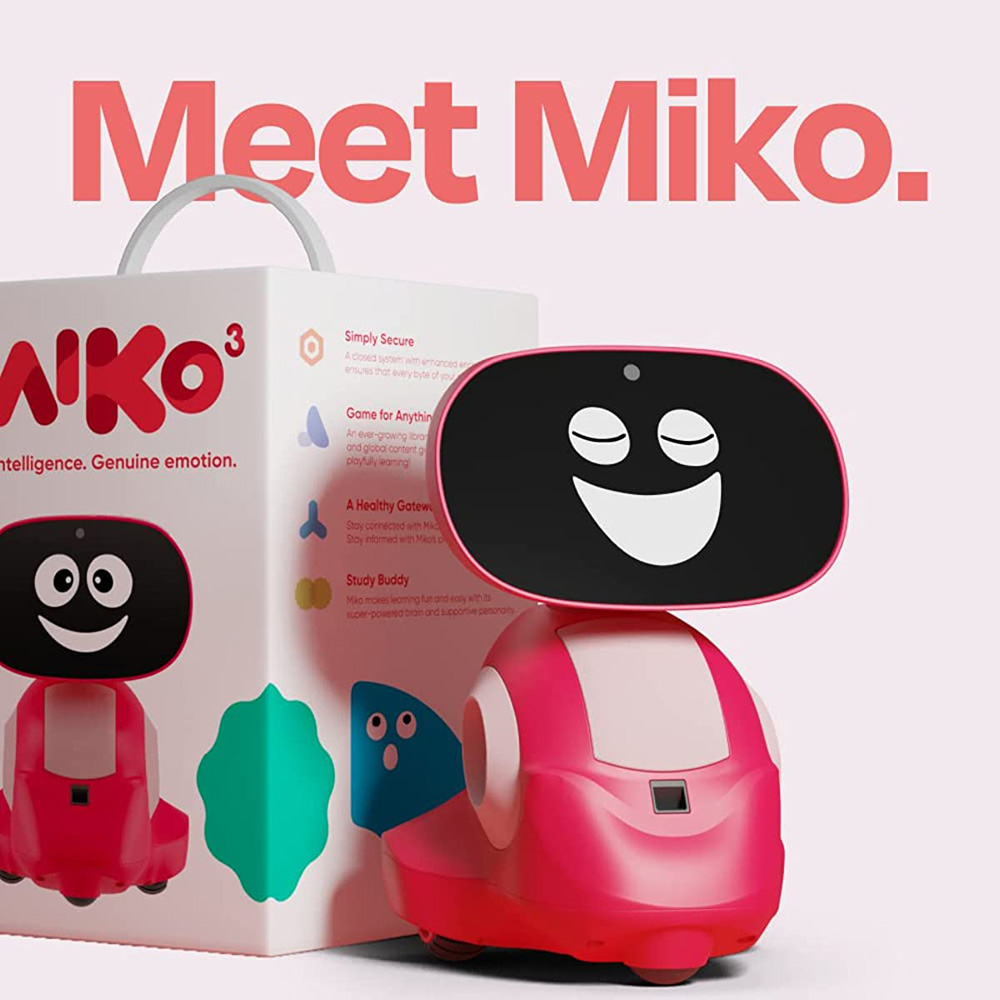

Miko 3
Companion robots for kids have been a major area for robot and AI tech, and we’re starting to see a proper market take shape. One popular choice is Miko, which is now on its third iteration. With dozens of emotional cues, it recognizes people and calls them by name, and gets to know kids day by day, responding to their moods — telling jokes, dancing around to shake off a case of the blues, and the like. Miko also comes loaded with 1000-plus games, puzzles, and stories, as well as a subscription plan that provides unlimited access to content from the likes of Oxford University Press, Cosmic Kids, and Tiny Tusks. The content covers a range of STEM activities, all of which are interacted with by the touchscreen and voice commands. ($250, miko.ai)
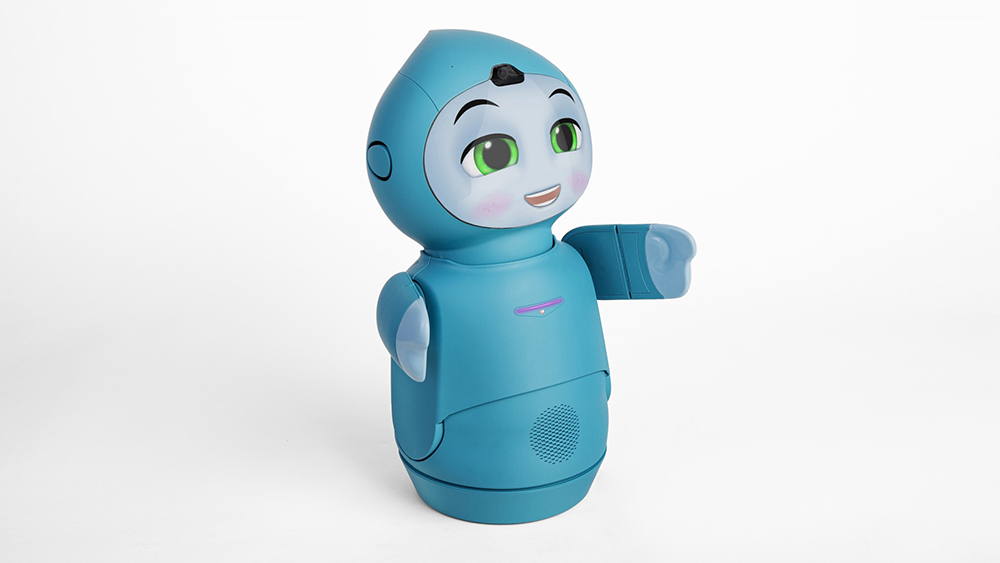

Embodied Moxie
A bit higher-end — $999, plus a monthly subscription that starts at $133 a month — Embodied’s Moxie robot looks like a Pixar character IRL. It rotates around to keep eyes on its playmates with its built-in camera, and its torso can bend up and down; especially to young kids, Moxie can seem impressively alive. Through conversation, games and tasks, the robot is designed to encourage social interactions in kids five to 10 years old, foster creativity through play, and teach emotional regulation techniques to help address anxiety. (embodied.com)
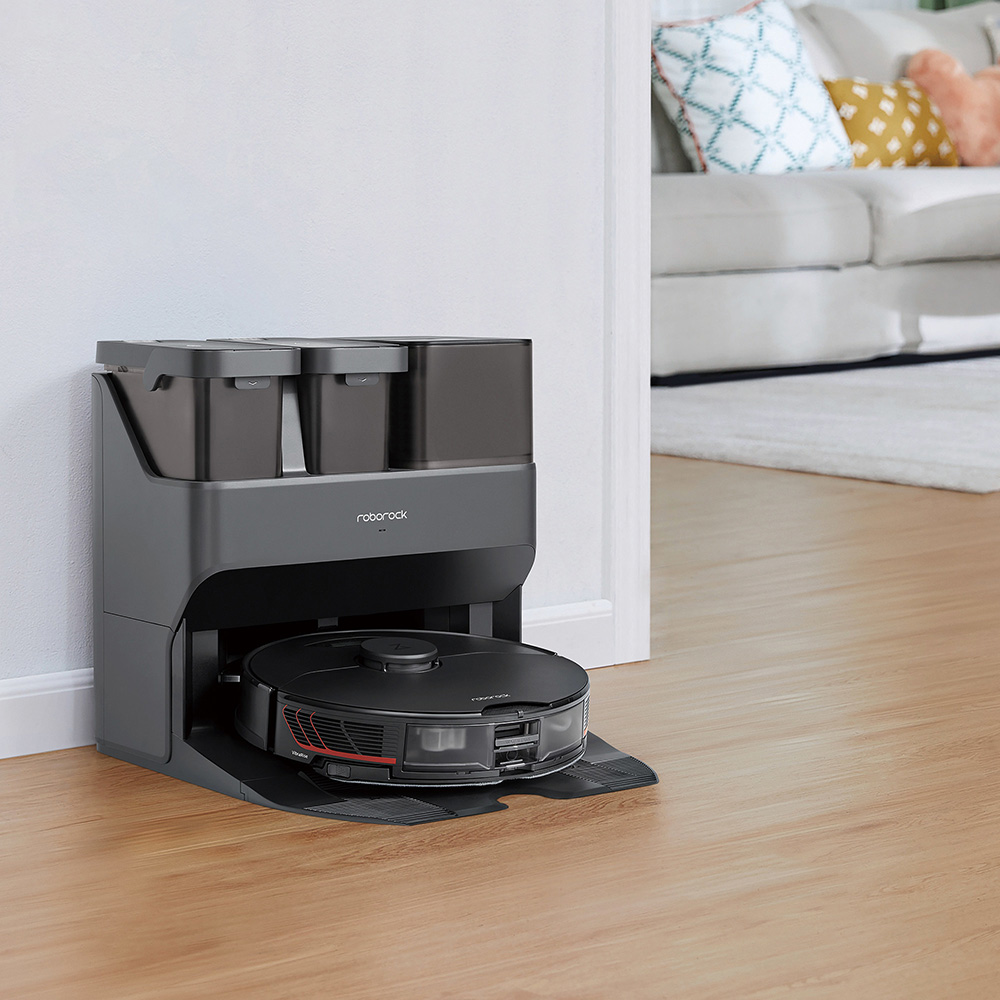

Roborock S7+
Roborock’s S7+ is among the latest wave of robovacs, which bring more features than ever to the table (or the floor, as it were). Firstly, not only can it both vacuum and mop your floors, it can also do so at the same time, meaning more efficiency overall. While hybrid cleaners typically avoid carpets while mopping, the S7+ lifts up its mopping pad when it detects carpet. Another new feature aims to take the major pain point out of robovacs — it comes with a self-emptying dustbin, which it sends to a larger storage unit attached to its charging base. While technically it doesn’t sanitize your floors — it uses water, not a soapy cleaning solution — this is still one of the most powerful, feature-packed cleaning robots on the market.
($950, us.roborock.com)


Gladwell Gecko
This small, wired device cleans windows with washable microfiber pads, using artificial intelligence to select the best cleaning pattern and detect window edges. While the Gecko does most of its work automatically, the user can also take manual control via the included remote to clean hard-to-reach spots. Of course, this device is handiest on high windows that aren’t easily accessible from the ground; fortunately, if the Gecko loses power, it is easily caught with its attached safety rope. ($200, gladwellclean.com)
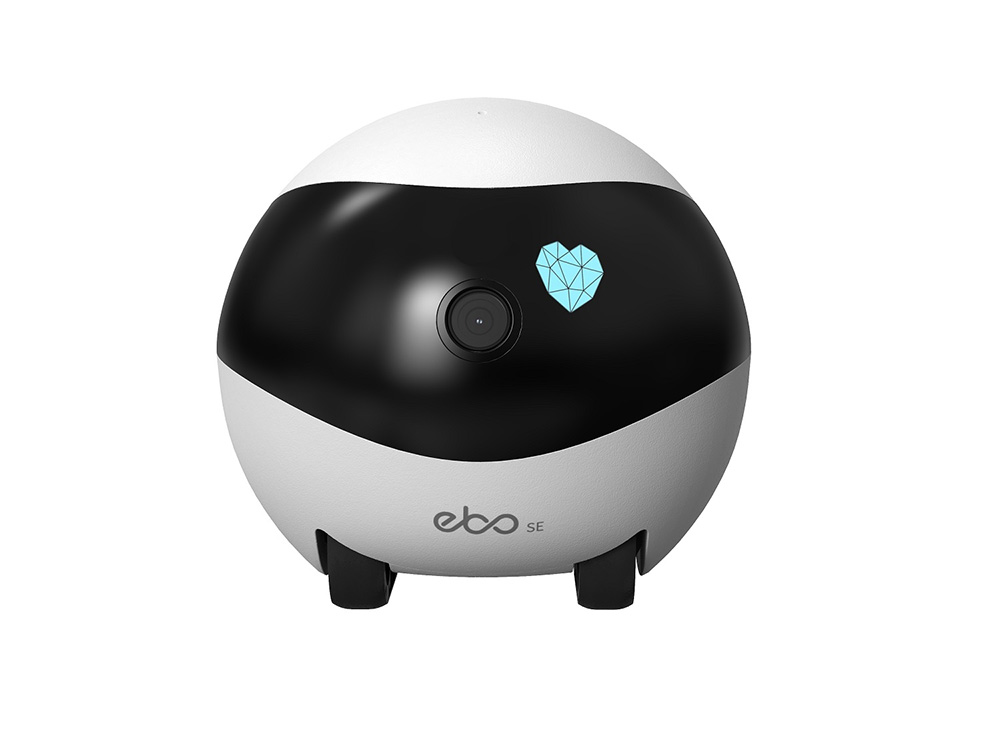

Enabot Ebo Air
Another target audience for the home robot: pets. While Enabot’s Ebo Air has multiple uses — its onboard 1080p video camera and microphone make it a generally useful home monitoring device — the fun is when a pet gets into the mix. The Ebo Air has wheels to move around, a laser with which to play with your cat, and a built-in speaker so you can talk to your pet when you’re not home. You can set a schedule to get the bot to seek out pets and use its laser when you’re not around, and unlike stationary security cameras, it can search for the pet in question that might be, say, hiding under the bed. Released earlier this year, the new Air combines the features of both of its predecessors, the EBO Pro and EBO SE, and adds a brushless silent motor and an anti-drop function. ($229, na.enabot.com)
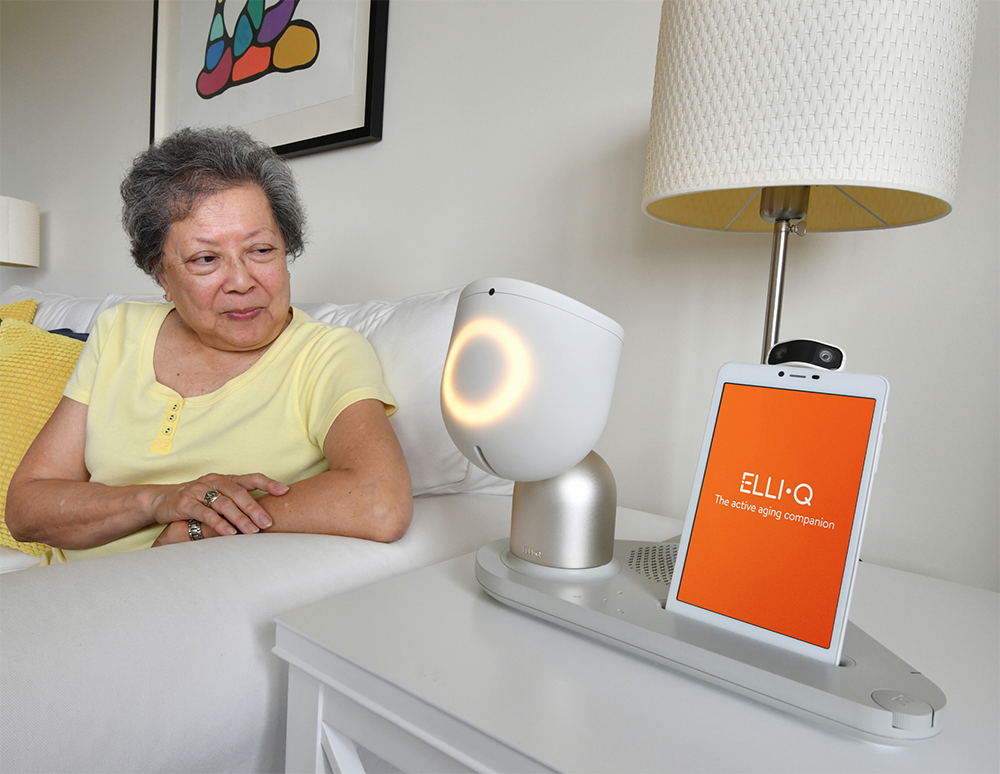

ElliQ
Designed not for young minds but rather for old souls, ElliQ is aimed at seniors, and particularly those who spend much of their days alone. It’s similar to the sort of AI assistants we’ve become used to — Amazon’s Alexa, Google Assistant, Siri — but doesn’t wait to be engaged with. It instead initiates things like conversations, reminders to, say, take medication, and suggests activities. It remembers stuff it’s told, and attempts to get to “know” its owner, engaging them in mindfulness techniques and trivia games. Like the Moxie, it can move in a way that brings it to life physically, with a variably lit area that can turn towards the user and gesticulate, albeit in a basic way. ($250, plus $30 per month subscription, elliq.com)
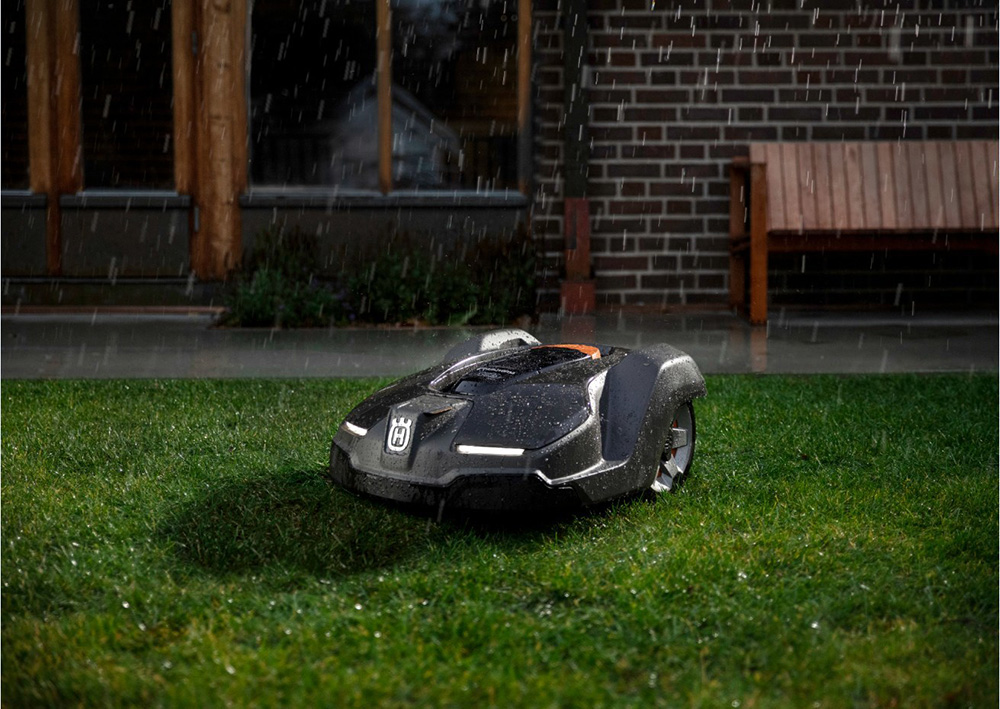

Husqvarna Automower 415X
With a rather extensive lineup of robot lawnmowers, Swedish brand Husqvarna has a robomower for lawns of various sizes. They all make use of a mobile app for starting, stopping, real-time monitoring, scheduling, and mapping your property. Available in May, the new 415X has lots of bells and whistles: Not unlike some advanced electric shavers, the three-blade design allows it to navigate the varied topography of different lawns without cutting the grass too short when it climbs inclines or cuts at an awkward angle. A new function called TargetHeight helps improve lawn quality, by automatically adjusting the cut height to meet the target set by the user. (Price TBD, husqvarna.com)
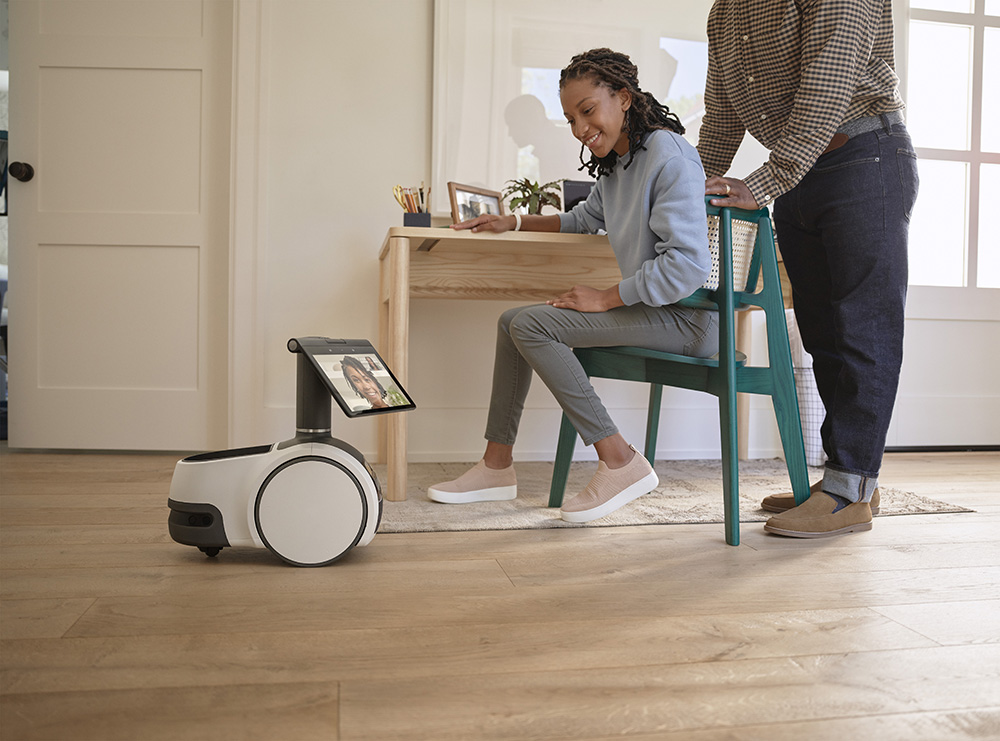

Amazon Astro
Sort of Amazon’s take on R2D2, Astro is the company’s first attempt to bring its Alexa artificial intelligence into customers’ homes in a more mobile, robotic form factor. In some ways, Astro functions as an Echo Show on wheels, but with a more “domestic” slant — it can dance around when asked, playing music as it does so. Astro’s discovery mode has it build a map of your home, narrated by you as you give it a tour tell it the name of the rooms it’s in. It’s designed as a helper, companion, and source of valuable information; while it’s been a bit of a slow burn (the product is still hard to find in the wild, and still has some bugs to sort out), you can bet Amazon has big plans for domestic robots in its future. ($1,500, amazon.com)
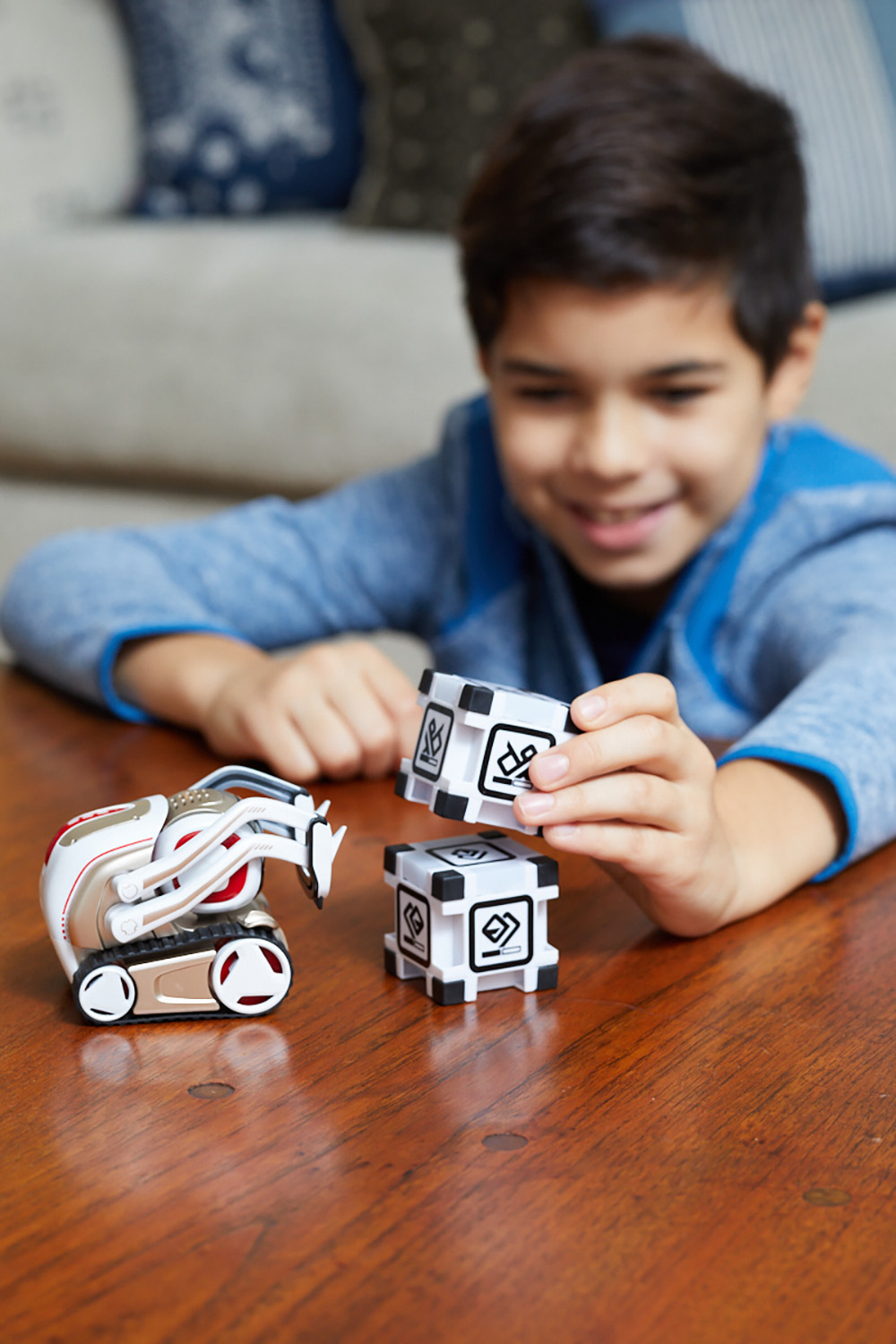

Cozmo 2.0
Cozmo 2.0 is the followup to 2016’s educational toy robot, small enough to live on your desk and designed to evolve and get to know its owner. Using the associated app, users can create simple programs to customize things like Cozmo’s movements, voice, and schedule. This second version features improved camera resolution and thereby facial recognition, able to make out when you’re smiling or frowning. It’s also more sensitive to its surroundings, avoiding things like falling off of tables. ($300, digitaldreamlabs.com)
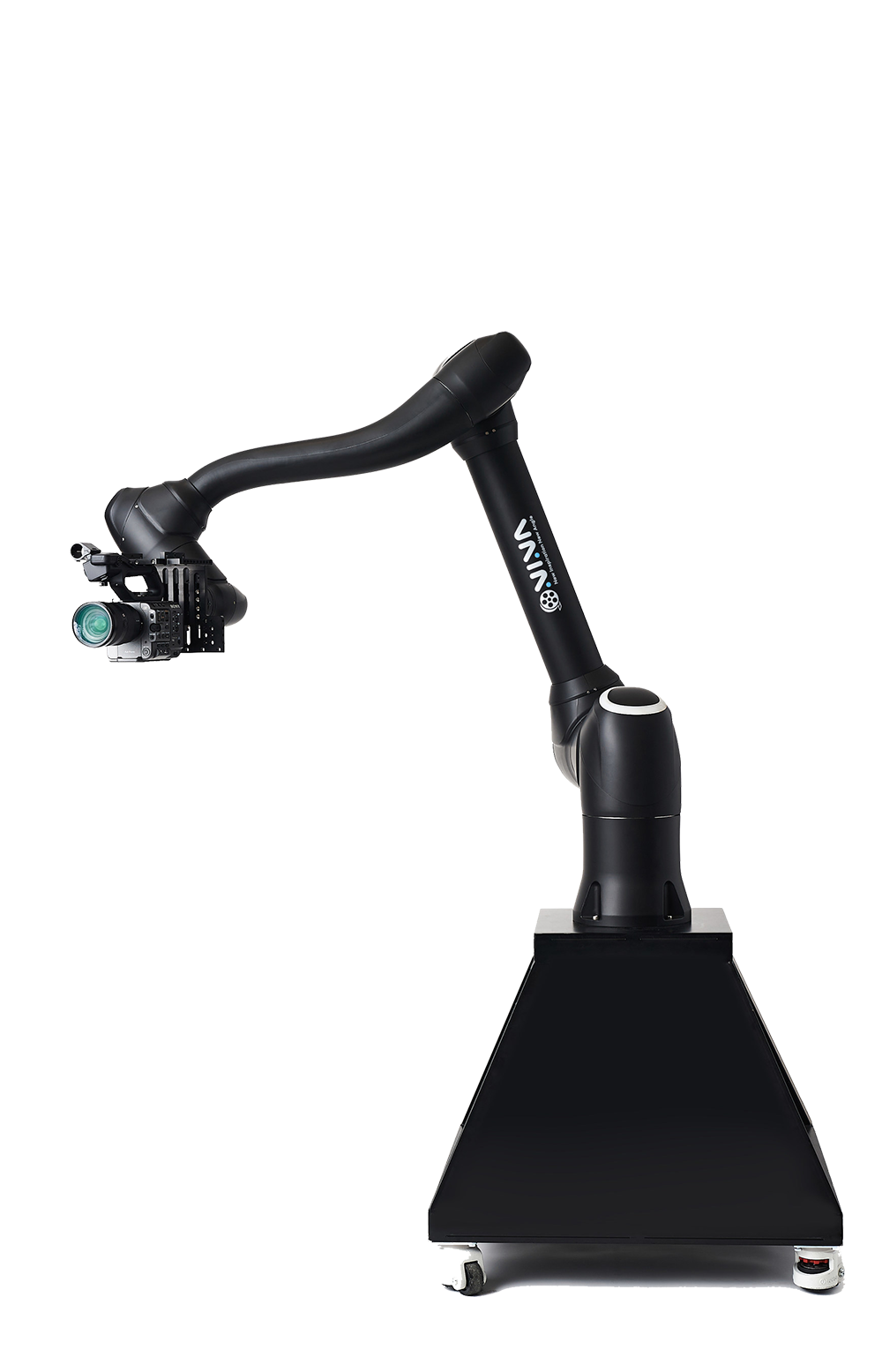

ROBOTS
Arm Handy
The Doosan Robotics NINA shoots from all the angles.
By BRENDA THELUSCA
When using a camera for video recording, there’s a limited range of angles that can be achieved depending on what equipment you use. At CES 2022, Doosan Robotics revealed the NINA, the South Korean company’s first camera robot that won the 2022 CES Innovation Award.
NINA (New Inspiration New Angle) is a robot that imitates the movement of a human arm and can hold cameras at any angle. The arm can extend up to 5.5 feet for shots up to 8.8 feet from the ground and zero meters below ground. This can help users get nice high aerial shots and low ground shots that would be difficult for a human arm to reach without injury. The NINA system automatically senses an object and calculates distance, allowing smooth and consistent robotic-assisted filming. The robot also has safety and emergency stop functions to avoid damaging itself or the camera by colliding with other objects. The collision-prevention technology is powered by six-torque sensors. Doosan Robotics is aiming to enter the U.S. market with its products this year.
“NINA brings in a whole new era for Doosan as we expand our offerings into the entertainment and content genre,” said William (Junghoon) Ryu, CEO at Doosan Robotics. “Our goal has been to deliver something accessible yet innovative for professional content creators across entertainment, advertising, social media, and other relevant industries, and we’re confident NINA will deliver in big ways across the board.”
The product package comes with a robot manipulator, control box, teaching pendant, Joypad controller, and device software. The joypad controller is a simple Xbox controller that can be connected to NINA for easier control of the device for those who don’t like using the robot manipulator or the control box. This is a very smart feature to include because most people know how to use game controllers and it’s simple to learn how to use them. NINA has a teaching pendant that can help users learn how to operate the camera robot efficiently, and creators can use the pendant to teach others how to achieve the angles they used.
The robot can work with action, movie, or DLSR cameras, so there is no limitation on what camera can be used. If users want to plan out what shots and angles they want, they can use the simulation mode feature. The simulation mode lets the user see how the angles that they choose will look in the camera before they start recording. This is helpful for the user to see if they want to make any changes to the angles they chose before they start recording. Instead of spending time and money doing constant retakes or changing the camera’s angles, the filming process can go faster because the creator already knows how the shots will turn out. Another interesting feature is that the NINA robot can share footage and angles of the video that was recorded so people can learn how to recreate certain shots they enjoyed.
The introduction of the NINA robot to the content creation industry could have the ability to expand the number of angles and shots in future commercials, movies, and music videos.
ROBOTICS
Robotic Resources
How autonomous technologies enhance human capabilities.
By Jeff Weiland, LG Business Solutions USA
Ever since the first modern robots were developed in the 1950s, the public’s fascination with autonomous machines has varied from excitement and hope to hesitance and fear, and everything in between. In the following decades, single-purpose robots began showing up on factory floors and in mailrooms, and average citizens grew more comfortable and familiar with digital technologies forming a central part of home life. While the dancing, jumping, self-navigating robots of today were still decades away, the controversy then was much the same: workers worried that machines might eliminate their jobs.
As history has shown time and time again, technological advances can disrupt entire industries and remove some tasks from the hands of human operators. However, the systemic effect is that machines are leveraged to make individual workers more productive, allow for the completion of previously impossible tasks, and free up human resources to handle more complicated or mentally demanding work. In many cases, these changes also create entirely new industries, such as the need for robot maintenance.
The meaning of the term ‘robot’ has also changed over time, with autonomous vacuum cleaners, lawnmowers and self-driving cars all falling under the modern umbrella of robots. At the same time, other autonomous machines are in development to perform surveillance, respond to emergencies in dangerous locations, deliver packages, assist in hospitality and retail establishments, and even perform surgery. Looking forward, it’s all but assured that robots and intelligent machines will exponentially advance in both their capabilities and their integration into daily human activities.
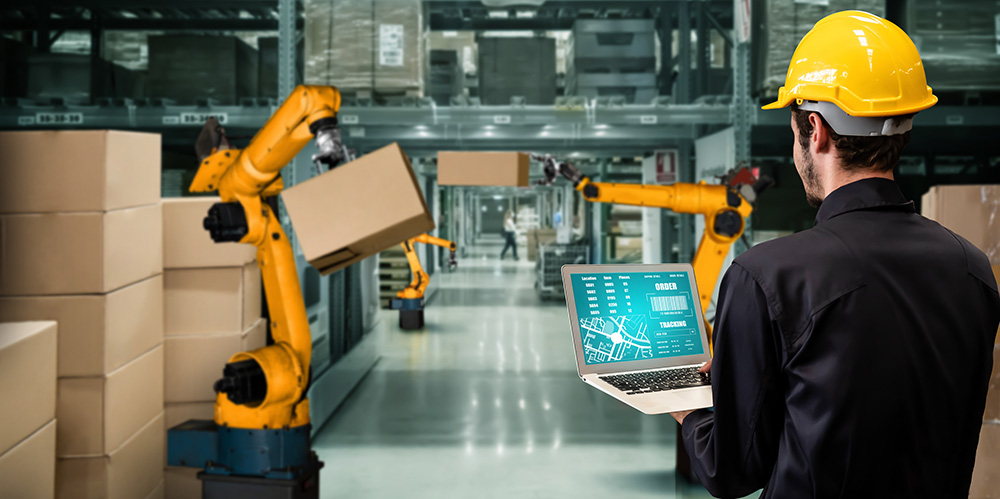

A Robot for Everything
Walk into a modern automobile factory, and you’ll see any number of single-task robots performing dangerous, essential jobs with greater accuracy and reliability than a worker could deliver. It’s the same story at food production facilities, where custom-built machines identify, sort, move, and package products alongside human workers. Meanwhile, farmers are beginning to gain access to self-navigating and self-driving tractors at the same time those functions are being made available in consumer vehicles for use on traditional roadways. If it seems like there is a robot for everything these days, perhaps it’s because there is.
As the components and technologies used to build robots have come down in price and complexity, everyone from home tinkerers to global corporations has invested time and resources developing new robotic tools to complete novel tasks for businesses and homeowners. As discussed, the term ‘robot’ is a large umbrella, and some may even consider a device as simple as a subject-tracking motorized surveillance camera to be a robot. The surveillance camera is a good example of a modern robot delivering functionality that was previously impossible or unfeasible due to the costs and labor required.
Today, increasingly rapid advances in autonomous technologies run parallel to a growing use of digital devices and services by average citizens. Countless parts of modern daily life would be unrecognizable to someone from the 1990s, let alone the 1950s. The public’s acceptance and adoption of digital technologies present unprecedented opportunities for robot makers and businesses to integrate robotics into more and more locations and roles, with some existing workers shifting to knowledge- and customer-service-based tasks.
The fervor has also begun to hit non-traditional sectors of the economy, with fast food companies testing small, autonomous delivery vehicles on college campuses,1 manufacturers partnering with airports and hotels to trial guest service robots, and a recent milestone that was achieved when a new robot exceeded human precision in surgeries conducted on pigs.
“The term ‘robot’ is a large umbrella, and some may even consider a device as simple as a subject-tracking motorized surveillance camera to be a robot.”
The Connected Effect
Robots can help us with everything from menial jobs, like vacuuming the floor, to demanding precision tasks, such as performing surgery. In the next few years, autonomous wheeled robots will likely begin assisting workers in restaurants, hotels, and retail stores by delivering food and products to customers so the humans can focus on conversations, recommendations, sales, and ensuring customer satisfaction.
Many of these locations will already be using control systems, security systems, distributed audio and video networks, and other digital technologies that may directly integrate with robot assistants. By making robots compatible and capable of communicating with existing systems, a hotel could allow guests to order room service through a touch panel with voice recognition, and then have a robot deliver the food and notify the guests on the touch panel or through audio such as, “Your food has arrived.”
In general, the more data an artificial intelligence device can capture, the better it will perform. This fact may influence some businesses to use specific robots and autonomous machines that are designed to be compatible with their existing technologies and can share information in real time. In effect, introducing advanced robotics into environments with compatible systems can increase the value of both the robot and the existing components. This points to the idea of single-supplier solutions, through which a company can develop its internal systems to all work together and rely on the same interfaces and protocols for interactions and updates.
Working Together
At the most basic level, every robot designed to date has been a tool meant to serve a specific function. With limited functionality or ability to adapt to changes in the environment, most commercial-use robots assist staff rather than replace the need for labor, just like any tool. In fact, companies and their workers can be more productive and have more time to focus on quality and service when robotic assistants help with things like moving goods from point A to point B or providing information.
As new types of robots become available to manage more tasks, business owners and staff will undoubtedly find more valuable needs to devote their efforts to, and will also be required to ensure the proper operation, charging, and cleanliness of any robots visible to customers.
For now, robots are mostly relegated to controlled environments where floorplans don’t change, and weather is not a factor. Still, more capable units will inevitably be able to tackle more fluid and complex situations and environments. As such, the need for human oversight and intervention may grow, such as a new Delivery Manager position that uses an app to observe delivery robots’ progress and help ensure customer satisfaction.
Where We Go From Here
The pace of innovations in robotics has accelerated as more businesses and individuals find use for them in daily life. Consequently, everyone from economists to students has their own ideas and expectations about what robots will look like and what functions they’ll serve in 10 years, 20 years, or 50 years. In the near-term future, we’re likely to see autonomous vehicles enter the rideshare market while smaller robotic vehicles make deliveries and AI-powered drones help first responders locate victims during emergencies.
The growing adoption of “Internet of Things” devices that are always connected and provide constant data is likely to overlap with advances in robotics to deliver benefits we can’t even articulate yet. As all of this progresses, manufacturers and businesses that deploy robotic assistants will have to carefully balance their introductions with the expectations of customers and employees who may need education to understand the value added by the new technology.
Nobody knows when we’re going to see a Rosie-like assistant that can run an entire household, but as robotics experts leverage existing smart technologies, integrate with IoT devices, and develop increasingly sophisticated autonomous capabilities, it might be sooner than we think.


Jeff Weiland is senior team lead at LG Business Solutions USA, a leading provider of robotic solutions.
SUMMARY:
- The public’s acceptance and adoption of digital technologies presents unprecedented opportunities for robot makers and businesses to integrate robotics into more locations and roles, allowing existing workers to shift to knowledge- and customer-service-based tasks.
- The systemic effect is that machines are leveraged to make individual workers more productive, allow for the completion of previously impossible tasks, and free up human resources to handle more complicated or mentally-demanding work.
- Looking forward, it’s all but assured that robots and intelligent machines will exponentially advance in both their capabilities and their integration into daily human activities.
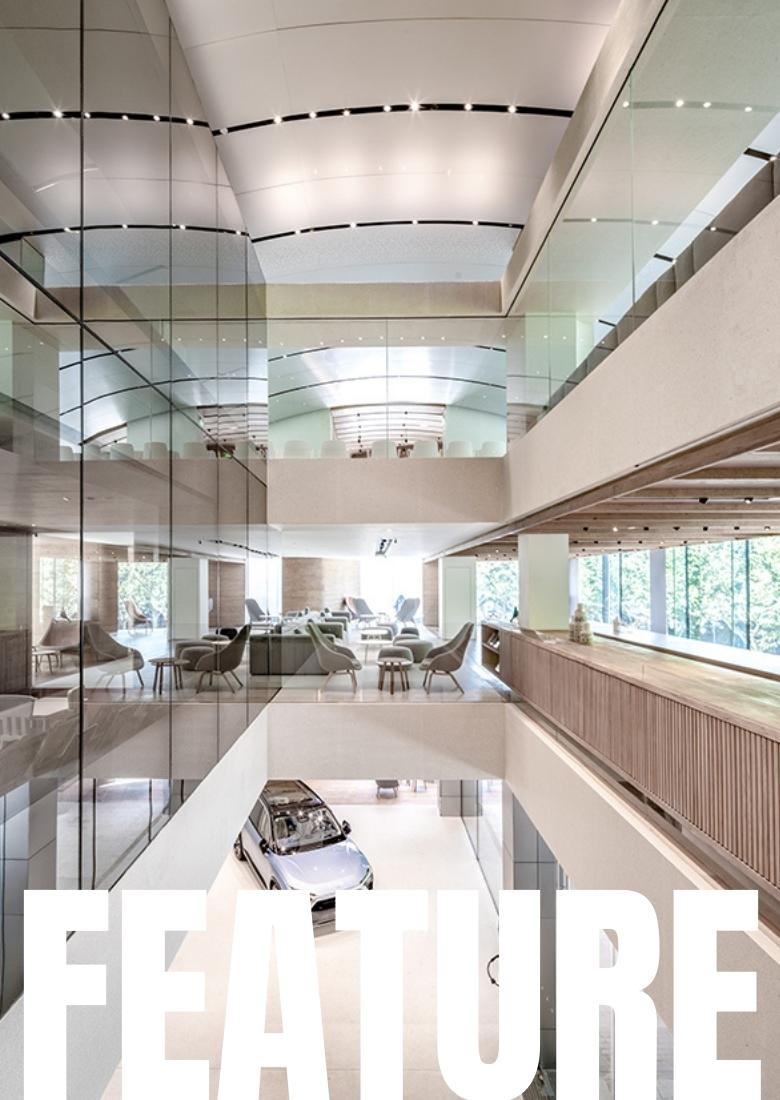

EXPERIENTIAL RETAIL
There’s More to the Store
Building community engagement with experiential retail.
By Saurabh Bhatnagar, VP of Corporate Development, NIO
When it comes to consumers and their purchasing methods, processes and experiences have changed significantly. The days when a customer visits multiple stores to find a good deal are essentially over. Brands have to be innovative and appeal to customers looking for the next new thing, and the opportunity for a more creative, comprehensive, and richer retail experience in today’s market is what helps generate excitement.
There are many benefits to a more stimulating retail experience and creating exposure to a new audience. Pushing boundaries instead of staying with standard messaging and maintaining a traditional client base can be the key to wider outreach. Unique and “unconventional” ways to communicate may be the path to reach out to potential new customers. It’s not about direct sales any more, but a lifestyle-centric approach where the retailer and consumer intersect to improve busy lives.
For example, Sharp and Samsung are evolving their standalone appliances to create a connected experience at home. Both companies have teamed up with retail partners and third-party solution providers to create advancements in the kitchen.


NIO House Library in Hangzhou, China.
A more imaginative retail experience is about engaging the retail outlet’s community. One way to do this is to provide exclusive benefits to boost engagement. For example, this can be done by creating “immersive experiences” for the community and the potential buyers/users. Another is to focus on vital emotions and brand values to create “fans” using common denominators, such as certain passions, like the environment, next-generation technology, or belonging to a “family” of like-minded individuals.
Best Buy’s Teen Tech Centers, such as the one in St. Louis, offered a digital art class. The class taught students how to use digital tools and develop skills. Local students also were able to use the Tech Center’s professional-grade recording studio to learn how to record and edit tracks.
We at NIO have expanded the premium electric vehicle (EV) retail experience that can potentially work and resonate across other retail categories. Creativity is key to staying ahead of the game. Developing mutually beneficial partnerships, which could be unconventional ones, can help expand reach, create buzz and exposure to new ideas and initiatives, increase share resources, bring operational and functional improvements, and help enhance the user experience. For example, NIO Life is NIO’s extension of an enjoyable lifestyle: a cross-sectional lifestyle brand working with more than 500 designers worldwide to introduce products into a user’s daily life.
Some brands in the EV market have already created an “image” and messaging that has resonated with earlier customers but may not have evolved in recent years. As a result, the established car-buying consumer and a first-time car buyer, who was not even considering an electric vehicle, can be compelled by these communications or unique partnerships to re-think their decision. The same can be applied to other industries and markets across retail.
When it comes to the EV market, the more imaginative new retail experience also includes understanding how the buyer can benefit from owning an electric vehicle, from learning about EVs and their impact on the environment to long-term financial benefits and overall comfort and technology. Therefore, the user experience from the get-go should be a premium one. After all, EV ownership is more of a lifestyle than just merely owning a vehicle.
NIO provides an environment beyond the regular showroom or temporary experience center with their NIO House as a “user enterprise.” Making the user experience more immersive and pleasurable is a top priority by providing community spaces where visitors, from current NIO car owners to community members, can relax, recharge, and share. The byproduct, of course, is hoping that the consumer connects and experiences the cars while in the NIO House.
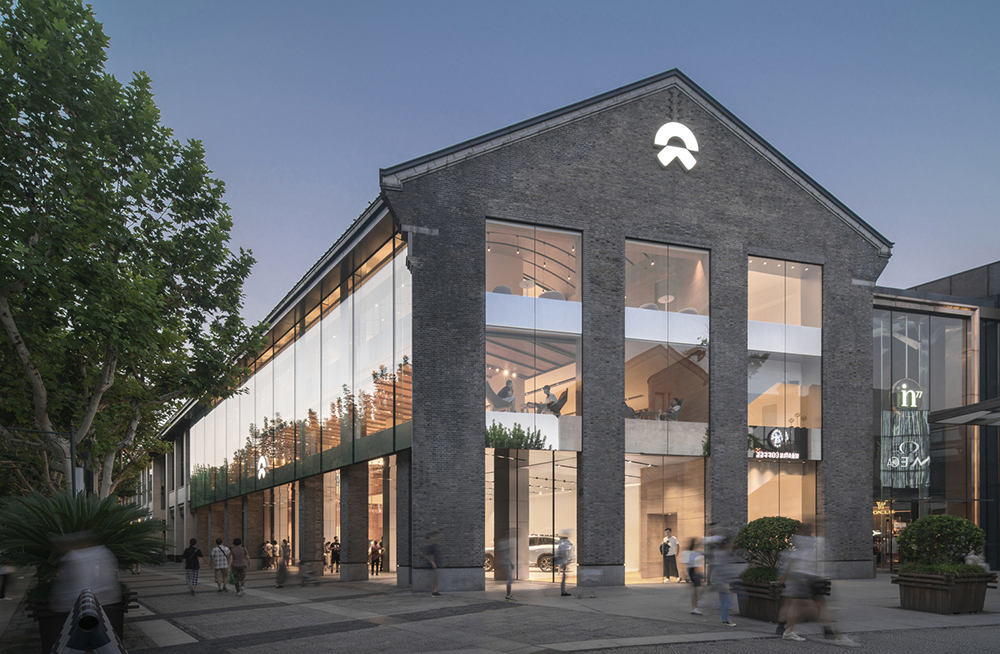

NIO House Hangzhou West Lake in Hangzhou, China.
A non-traditional showcase space aims to make current and potential customers feel at home and undergo the manufacturer’s experience. The retail space is no longer a place to push sales, but for feeling and familiarity with what the brand can bring. These spaces include cafes with signature drinks, libraries, conference rooms, lounges, and childcare services. If nothing else, these unique showrooms and experience centers give manufacturers and the retailer control over a shopping experience separate from a traditional, hard sell.
Car manufacturers, such as Audi, Cadillac, Mercedes, Lexus, BMW, Hyundai’s luxury sub-brand Genesis, and NIO are already leaping and forging a deeper relationship with their current customers and potential new ones beyond the purchasing of a vehicle. As a result, consumers are being enticed into “brand experience centers” to check out the latest manufacturers’ latest vehicles without the hard sell of a showroom or car lot. For example, manufacturers have created temporary “pop-up” locations that include theaters, galleries, teahouses, cafés, and even fully operational restaurants to conduct outreach to potential new customers. Other experience centers have showcase spaces for higher-end car models to galleries that revolve around classic and contemporary vehicles from a brand, all to help change the consumer perception.
A retail experience can also be made “smarter” when accompanied by an app, and the EV retail industry is no different. A specific app can provide a premium and unique user experience for the potential buyer and the actual customer. As a result, many companies have started investing more in the mobile experience. For example, NIO has developed a unique app where users can schedule a test drive, customize, purchase a vehicle, chat online with other users and employees about their experiences, request service or services, request power replenishment services, or even purchase branded services merchandise.
An intelligent retail experience allows users to engage with others, enjoy their purchases, find insights, explore activities to do, and share moments and joy. With the inclusion of apps, users can conveniently connect an app to their vehicle for one-step services while staying connected with news shared by users and even employees and executives. It can be a social platform for users (both potential and actual customers) to communicate.


How to Create Unique Retail Experiences
Unique retail experiences engage users while they are in the store, and physical spaces can bring people together. Here are three ways to elevate the in-store experience.
- Reinvent spaces through simple design and/or inventory changes for greater interactivity.
- Create mini-shops or experiences within stores that match the community and its interests. Example: Social media “nooks” where spaces are social-media friendly.
- Apps: Utilize augmented and/or virtual reality to link the online and offline.
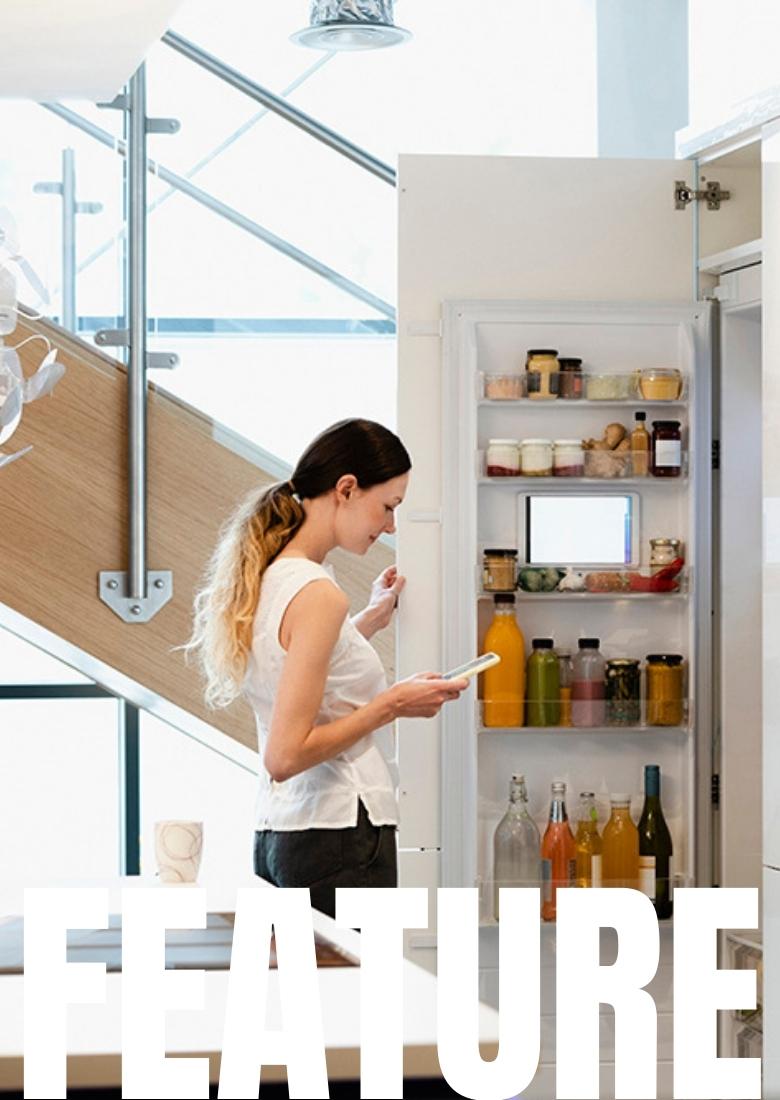

CONNECTED KITCHENS AND BATHROOMS
Kitchens and Bathrooms Are Getting Smarter
Why it’s time to bring technology into the remodeling conversation about these rooms.
By Giles Sutton, Senior Vice President of Success and Sales, CEDIA
Home remodeling has been one of the economic success stories of the pandemic. According to Harvard’s Joint Center for Housing Studies, remodeling spending in the U.S. has risen from $332 billion USD in Q1 2020 to $368 billion by the end of last year – and that number is forecast to increase $432 billion by the close of 2022. The home technology industry has certainly felt the benefit of this nest-feathering: spending on consumer technology rose at very similar rates to remodeling in 2020 and 2021, according to the Consumer Technology Association (CTA).
Dealers should be paying attention to Venn Diagram overlap between remodeling and technology consumer spending. Historically, homeowners invest more dollars per square foot overhauling their kitchens and bathrooms than any other room in the house. As it happens, these rooms are also the current focus of immense home technology innovation. In 2022, any conversation about a major kitchen or bathroom renovation should include a discussion of how the homeowner wants to update the technology in the space.
Particularly in the upscale and luxury sectors of the market, every room in the house is getting smarter. Elegant, Instagram-worthy aesthetics are still the expectation, but increasingly, homeowners are expecting their homes to work for them, taking care of mundane tasks like closing the blinds and lowering the lights, warming the sheets, or cooling the gym, locking the door and securing the network. This expectation – for both beautiful design and thoughtful functionality – is opening customers’ minds to tech-enabled experiences in rooms that have traditionally been stuck firmly in the mid-20th century. Homeowners are exploring how they can create more zones within the home that serve the diverse needs of their lives.
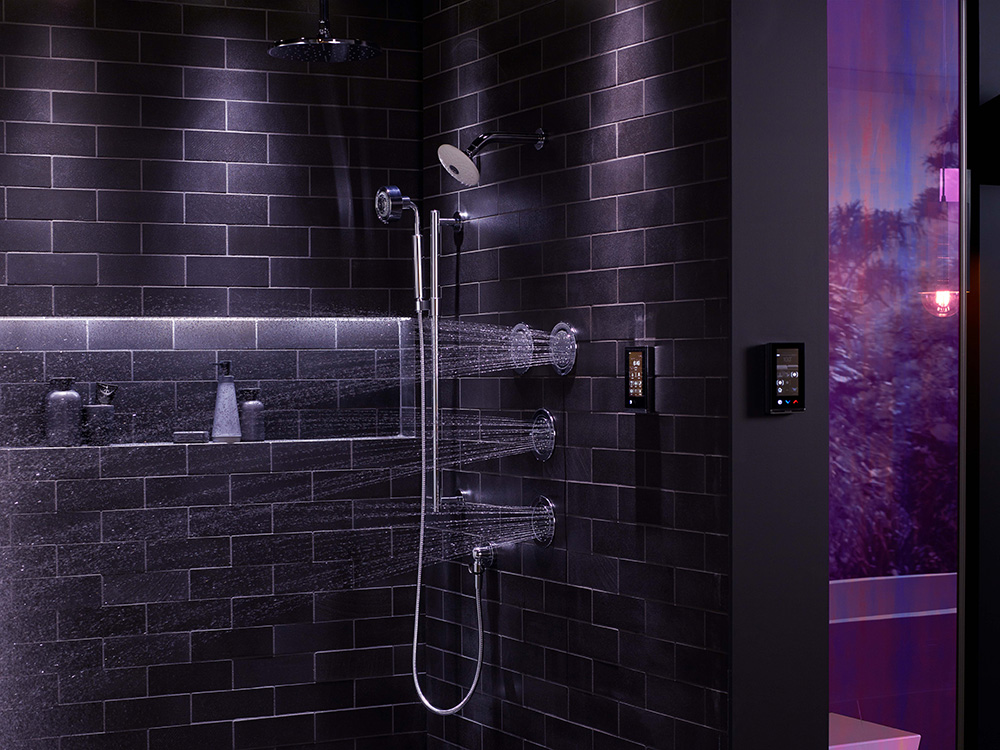

Kohler’s smart shower.
The At-Home Spa Experience
Master bathrooms often endeavor to evoke a spa experience. Here’s the problem, though: a spa has a staff. Creating your own at-home experience – drawing the perfect bath, setting the lights and music just so, prevailing on your partner to warm your towel in time for your emergence – is a lot of hassle for a little relaxation. In today’s luxury smart bathroom, much of that work is done by the room itself. For example, Kohler’s new PerfectFill technology allows homeowners to fill a bathtub to their exact specifications – timing, depth, and temperature – with a voice or mobile app command. It’s an approach that makes preparing a relaxing bath much more like booking a spa treatment.
Once the spa experience begins, interruptions should be kept to a minimum. The homeowner doesn’t want to have to get out of the bath to adjust the lighting, the volume of the music, or the temperature of the air. More than perhaps any other room in the house, bathrooms can benefit from voice control. HVAC, lighting, audio, and now water temperature and flow systems can all be operated via vocal commands. With the assistance of a professional integrator, these systems can be integrated together to act in harmony, creating a true at-home spa experience without the obligation to act as both customer and staff.
The Clever Kitchen
All the leading appliance manufacturers, including LG, GE, Bosch, and Monogram, are emphasizing the smart capabilities of their products. In isolation, smart appliances can seem like a curiosity – does a blender really need to be part of the Internet of Things? – but their value is revealed as part of an integrated system. A smart appliance can talk to any other smart devices that are part of the kitchen renovation, which can lead to some very clever conversations.
In a kitchen with well-integrated technology systems, any single action by the homeowner might trigger a number of automated responses that all subtly work together to improve the function of the space. Starting the range hood fan might increase the volume of any music or videos playing. Igniting a stove burner could automatically turn on task lighting overhead. Opening the refrigerator for a midnight snack could also turn on soft, low lighting to guide you back to bed.
The modern kitchen is a vibrant, multi-use space: equal parts workspace, gathering place, and entertainment venue. Many homeowners have “scenes” for entertaining, relaxing, and other activities, programmed to initiate specific lighting levels, colors, and music. Smart appliances can be integrated into those scenes, not only matching their lighting to the environment, but – for example – increasing cold airflow into the refrigerator or wine cooler to account for frequent openings. Very few “smart devices” have value on their own, but they can work together in fairly magical ways.
Getting Down to Brass Tacks
For both kitchens and bathrooms, there is an important reason to raise technology upgrades during a larger remodeling phase, and it’s not that the customer’s wallet is already open. Rather, it’s to save significant money redoing work in the future. Homeowners will get by far the most value out of their smart systems if they are integrated during either the initial build or a significant renovation. Some of the most exciting kitchen and bathroom technology capabilities – Kohler’s smart shower controls, for instance – require wiring and infrastructure behind the tile. Retrofitting these systems after the room is otherwise complete isn’t just inconvenient; it’s actually impossible. If they don’t have proper guidance, customers may miss the window on these elevated experiences.
Homeowners will also miss out if they try to cobble these experiences together entirely on their own. The smart kitchen and bathroom may now have access to classic design, but the technology is still cutting edge. This is why Kohler has joined with other manufacturers in emerging markets by becoming part of CEDIA’s Propel program: they know they need to be able to connect their customers to experienced custom technology integrators to deliver on the full promise of their innovations.
Dealers as a whole would be well-advised to follow Kohler’s lead. Make technology part of the kitchen and bath remodeling conversation, but be prepared to bring in qualified integrators to help realize the vision. CEDIA can assist in connecting you to professionals in your area; visit cedia.net to learn more.
SUMMARY:
- Integrated technology systems in the bathroom can facilitate a true at-home spa experience.
- The value of smart appliances is revealed in how they interact with other smart devices.
- Successful smart kitchens and bathrooms require a technology conversation – including a professional integrator – early in the building or remodel design phase.


SOCIAL MEDIA
Let’s Talk About Social Audio
How businesses can leverage platforms like Clubhouse for marketing and better customer engagement.
By BRENDA THELUSCA


Kristin Meyers, the senior executive of Audio at the United Talent Agency (left), Audio Collective Co-Founder Toni Thai Sterrett (center) and Clubhouse Head of Community and Creators Stephanie Simon (right).
First, we had the radio, then podcasts, and now we have social audio. The latest evolution of audio broadcast content allows for multiple people to have discussions with people all over the world through voice-only platforms and apps. It started with Clubhouse, which experienced fast and high growth during the pandemic, but since then has slowed down a bit. Even so, multiple bigger tech companies such as Spotify, Twitter, and Facebook have joined in on the social audio trend and created Spotify Green Room, Twitter Spaces, and Facebook Live Audio Rooms. In March 2021, the Clubhouse app had received 13 million downloads. It allows up to 8,000 people in a chat room, which puts it far ahead of its competitors. Facebook Live Audio Rooms has a limit of 50 participants, Twitter Spaces allows up to 13 people, and Spotify Greenroom allows up to 1,000 people to join a session and has only 110,000 active users. Even though Clubhouse is less popular than it once was – going from 9 million downloads in June 2021 to 920,000 downloads in November 2021, according to AppAnnie – it is still the category leader. At a panel earlier this year at CES, “The Future Sounds Amazing: Betting on Social Audio,” the discussion focused on the rise of social audio: What exactly constitutes social audio and what makes it so appealing.
How social audio platforms work
The panel was hosted by Kristin Meyers, the senior executive of Audio at the United Talent Agency (UTA), and she was joined by two panelists, Audio Collective Co-Founder Toni Thai Sterrett and Clubhouse Head of Community and Creators Stephanie Simon. Starting off the panel, Simon took the time to explain that her company, Clubhouse, is an audio-based, interactive social media platform and app where people can discuss or listen to topics that interest them.
Instead of just listening as one would do with a podcast, Clubhouse users can join in on the conversation. “Voice is the oldest medium, so it was a natural process that expanded into the social network,” Simon said.
Chiming in, Sterrett described her first experience using Clubhouse: “I just entered a game room with all these people, then all of a sudden I was talking to like-minded people about life, travel, and other things from all over the world,” she said.
More than chat
No doubt, there is a lot of potential for social audio to be used in different ways other than discussions. There’s a program called “Clubs” on the Clubhouse app that allows communities to come together and host different programs. For example, there’s a lullaby club where different musicians sing people to sleep. This is a smart way for people to market their musical talents if they are trying to reach more people or attract attention from a music label. “It’s not just a place to talk, it’s a place to experiment and create together,” Sterrett explained. Any user can create a club, but it is only open to the people that they follow back. This way users can control the people that are admitted into the clubs they make.
If a retailer is selling cameras, for example, it could hold a club for photographers and hear what features they love about certain cameras and which models they use on their projects. One person could mention how they like using smaller cameras for nature photography, while someone else could say they want smaller cameras for their indoor studio. The retailer can also give consumers advice on how to best utilize certain products or what products are best for their customers.


Facebook Live Audio Rooms
Everyone will be heard
Social audio can be used as a way for people to get advice or see certain situations from multiple points of view. This also gives power to people whose opinions are often overlooked because they have a platform where people are willing to listen. Retailers can use this to their advantage because they can get direct feedback from consumers, or allow consumers to ask retailers questions about certain products. Simon mentioned that, in her clubs, she makes sure that women are not cut off or belittled when they are speaking. (As a woman myself, I appreciated this fact because I have experienced being interrupted while trying to speak my mind, and how unimportant it made me feel. Just having one person who is willing to listen, even on social media, is a comforting factor for me.) Sterrett also spoke about how she uses the Clubhouse app to hear more female and diverse voices in the male-dominated film industry.
Other male-dominated markets like the gaming industry could benefit from listening to its female audiences because they are still customers with demands for certain products. Some of my female gamer friends complain how the size of controllers is too big for their hands and that it affects their gameplay. Also, a few girls have complained about how gaming accessories for girls mainly come in the color pink, and not every girl likes pink. If a gaming company had a social audio session with its female audience, it would be able to get more feedback on what colors women want, along with other features that would make its products more female-friendly.
When asked by Meyers who she thought thrived on social audio platforms, Sterrett replied: “Someone who knows how to listen [because] listening requires a great deal of empathy. Paul, the founder, always said that you can hear people’s hearts.”
What’s next?
Meyers moved on to talk about how people speculate that the popularity of social audio will decline once the pandemic has ended and people start physically socializing again, raising the question of how social audio fits into the greater social network landscape.
Per Sterrett, social audio isn’t limited to discussions only, and experimenting with the medium can bring new possibilities. As an example, she cited Clubhouse’s recent collaboration with Warner Media and SXSW 2021, whereby fans on the app had the opportunity to talk to actors and writers about the show. CE manufacturers could do something similar, hosting a “Club” where consumers have the chance to ask them questions about products. For example, if consumers or retailers wanted to know about a manufacturer’s new sustainability efforts, they could attend an audio session in which that company goes into detail about how its packaging is green and how its recycling programs work.
Companies (and retailers) could also tap into social audio to get customer feedback in order to improve its products. If a headphone brand that’s specific to runners held a social audio session, it could listen to those athletes give feedback on what problems they run into while using the earbuds on a job, or what they would want added to the product to satisfy their needs. Not all requests can be met, but at least the manufacturer can give a detailed explanation as to why certain things would not be able to be added to its products.
“You can tweet and cross your fingers and hope that person will respond to your tweet, but now [with social audio] that person can interact with the actor and ask their burning questions,” Sterrett said. “Scripted content could be used on social audio as well as table reads.” An event like this will surely grab users’ attention because who wouldn’t want the chance to talk to their favorite actor? While social audio is fairly new to social media, it does have the potential to change depending on how much people are willing to experiment with audio. “If you have a voice, the social audio space can be used in any way the user chooses to use it,” said Sterrett at the end of the panel. “The only limit is your imagination.”
STAT SHOT
CE Industry By The Numbers
COMPILED BY SAM HITT
10,000...
…new positions will be added to the Dollar General workforce in 2022, as the company looks to add new retail and distribution locations.


30 Knots…
…is the top speed of the Candela C-8 daycruiser, an electric hydrofoil aqua craft that skims above the surface of the water.


1959…
…was the year that produced two iconic pieces in the music and automobile worlds: the Gibson Les Paul Standard, and the Triumph Bonneville T120. This year, Gibson and Triumph are teaming up to auction off reimagined versions of these two classics as the highest fundraiser reward for the 2022 Distinguished Gentleman’s Ride.


$15,000…
…was raised by Nationwide, Next Level Distribution, and Tempur-Sealy International to be donated to the Autism Speaks foundation.


22%…
…of all eCommerce transactions are facilitated by the PayPal platform, which has a network of over 400 million users.


DEALERSCOPE PODCAST
Welcome to the Dealerscope Podcast – Your Source for all B2B trends in Retail, Tech and Biz!
In the high-strung consumer electronics retail business, it can be hard to take a moment to step back and breathe. The Dealerscope Podcast gives CE retail leaders the chance to kick back, relax, and talk shop in a casual setting.
Get Dealerscope
and Connected Design
delivered to your doorstep
or to your email.
Click on the links below to update how and where you receive your issues! Change your mailing address or request a change from print to digital, subscribe to our newsletters, or just head to our websites.
CONNECTED DESIGN
Subscribe to Print Magazine
Renew Your Subscription
Subscribe to Newsletters


OFFICES
100 S. Juniper St., 3rd Floor
Philadelphia, PA 19109
132 West 31st Street, 9th Floor
New York, NY 10001
EDITOR IN CHIEF
Tom Samiljan
tsamiljan@ctlab.media
CT LAB EDITORS
Sam Hitt
Erinn Loucks
CONTRIBUTORS
Saurabh Bhatnagar
Nancy Klosek
Johan Liljeros
Egon Sanders
Stephen Silver
Giles Sutton
Fred Towns
Jeff Unterreiner
Jeff Weiland
CREATIVE
Astrid von Krenski
(940) 727 8595
avkrenski@ctlab.media
CHIEF SOCIAL MEDIA AND WEB EDITOR
Brenda Thelusca
(561) 752-6670
bthelusca@ctlab.media
GROUP PUBLISHER
Tony Monteleone
(718) 216-2046
tmonteleone@ctlab.media
OPERATIONS MANAGER
Vicki Manucci
vmanucci@ctlab.media
CIRCULATION & DISTRIBUTION
Carrianne Ramsey
cramsey@ctlab.media
ACCOUNTING/HR MANAGER
Catalina Gonzalez
cgonzalez@ctlab.media
CHIEF OPERATING OFFICER
Alice Schmalzl
(940) 612-9581
aschmalzl@ctlab.media
OFFICES
100 S. Juniper St., 3rd Floor
Philadelphia, PA 19109
132 West 31st Street, 9th Floor
New York, NY 10001
dealerscope.com
Publisher of Dealerscope, and Connected Design
Copyright ©2022 CT Lab Global Media LLC
CT Lab Global Media is a diversified publisher of business and professional magazines. This publication is provided with the express understanding and agreement that the information and data within it will be solely for internal use and will not be used for the creation or updating of mailing lists for sale or distribution to third parties. Printed in the U.S.A.


